Denon AVR-3310CI User Manual

AV SURROUND RECEIVER
AVR-3310CI
Owner’s Manual
 Graphical User Interface
Graphical User Interface
Use this manual in combination with the operating guide displayed on the GUI screen.
GUI Menu Operation (vpage 26)
GUI Menu Map (vpage 25)
Remote Control Unit Operations (vpage 86)
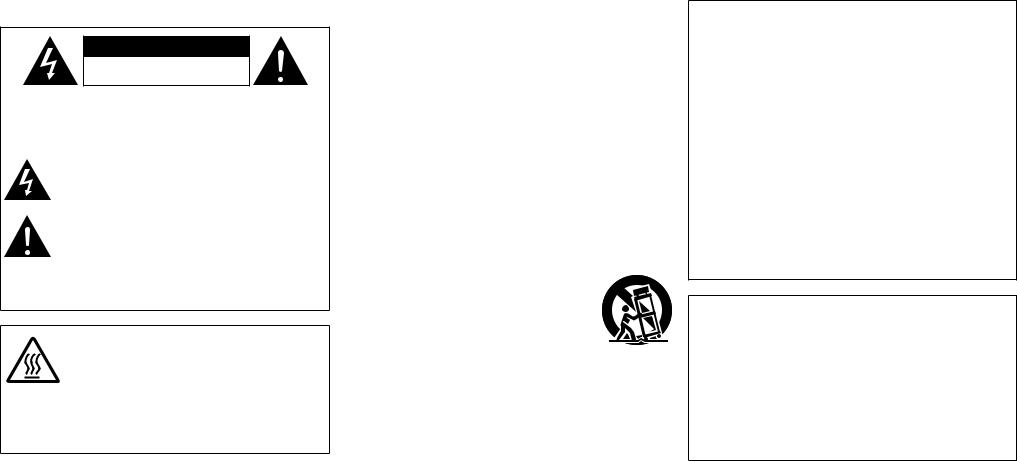
nSAFETY PRECAUTIONS
CAUTION
RISK OF ELECTRIC SHOCK
DO NOT OPEN
CAUTION:
TO REDUCE THE RISK OF ELECTRIC SHOCK, DO NOT REMOVE COVER (OR BACK). NO USER-SERVICEABLE PARTS INSIDE. REFER SERVICING TO QUALIFIED SERVICE PERSONNEL.
The lightning flash with arrowhead symbol, within an equilateral triangle, is intended to alert the user to the presence of uninsulated “dangerous voltage” within the product’s enclosure that may be of sufficient magnitude to constitute a risk of electric shock to persons.
The exclamation point within an equilateral triangle is intended to alert the user to the presence of important operating and maintenance (servicing) instructions in the literature
accompanying the appliance.
WARNING:
TO REDUCE THE RISK OF FIRE OR ELECTRIC SHOCK, DO NOT EXPOSE THIS APPLIANCE TO RAIN OR MOISTURE.
CAUTION:
HOT SURFACE. DO NOT TOUCH.
The top surface over the internal heat sink may become hot when operating this product continuously.
PRECAUTION:
SURFACE CHAUDE. NE PAS TOUCHER.
La surface supérieure du dissipateur de chaleur peut devenir chaude si vous utilisez ce produit en continu.
IMPOTANT SAFETY
INSTRUCTIONS
1.Read these instructions.
2.Keep these instructions.
3.Heed all warnings.
4.Follow all instructions.
5.Do not use this apparatus near water.
6.Clean only with dry cloth.
7.Do not block any ventilation openings.
Install in accordance with the manufacturer’s instructions.
8.Do not install near any heat sources such as radiators, heat registers, stoves, or other apparatus (including amplifiers) that produce heat.
9.Do not defeat the safety purpose of the polarized or grounding-type plug. A polarized plug has two blades with one wider than the other. A grounding type plug has two blades and a third grounding prong. The wide blade or the third prong are provided for your safety. If the provided plug does not fit into your outlet, consult an electrician for replacement of the obsolete outlet.
10.Protect the power cord from being walked on or pinched particularly at plugs, convenience receptacles, and the point where they exit from the apparatus.
11.Only use attachments/accessories specified by the manufacturer.
12.Use only with the cart, stand, tripod, bracket, or table
specified by the manufacturer, or sold with the apparatus. When a cart is used, use caution when moving the cart/ apparatus combination to avoid injury from tip-over.
13. Unplug this apparatus during lightning storms or when unused for long periods of time.
14.Refer all servicing to qualified service personnel.
Servicing is required when the apparatus has been damaged in any way, such as power-supply cord or plug is damaged, liquid has been spilled or objects have fallen into the apparatus, the apparatus has been exposed to rain or moisture, does not operate normally, or has been dropped.
15.Batteries shall not be exposed to excessive heat such as sunshine, fire or the like.
CAUTION:
•The ventilation should not be impeded by covering the ventilation openings with items, such as newspapers, tablecloths, curtains, etc.
•No naked flame sources, such as lighted candles, should be placed on the unit.
•Observe and follow local regulations regarding battery disposal.
•Do not expose the unit to dripping or splashing fluids.
•Do not place objects filled with liquids, such as vases, on the unit.
ATTENTION:
•La ventilation ne doit pas être gênée en recouvrant les ouvertures de la ventilation avec des objets tels que journaux, rideaux, tissus, etc.
•Aucune flamme nue, par exemple une bougie, ne doit être placée sur l’appareil.
•Veillez à respecter les lois en vigueur lorsque vous jetez les piles usagées.
•L’appareil ne doit pas être exposé à l’eau ou à l’humidité.
•Ne pas poser d’objet contenant du liquide, par exemple un vase, sur l’appareil.
CAUTION:
To completely disconnect this product from the mains, disconnect the plug from the wall socket outlet.
The mains plug is used to completely interrupt the power supply to the unit and must be within easy access by the user.
PRECAUTION:
Pour déconnecter complètement ce produit du courant secteur, débranchez la prise de la prise murale.
La prise secteur est utilisée pour couper complètement l’alimentation de l’appareil et l’utilisateur doit pouvoir y accéder facilement.
I
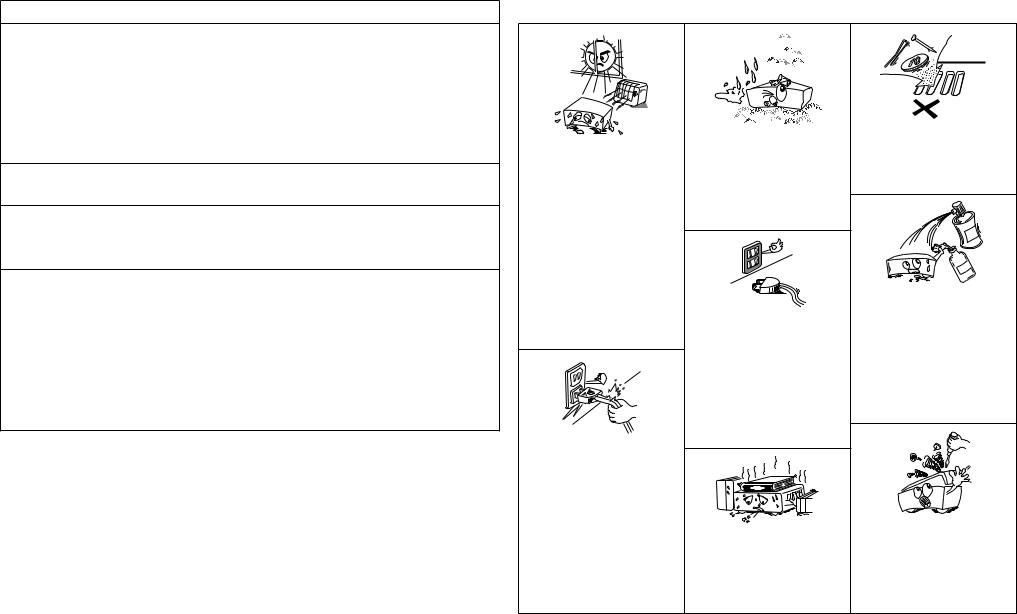
FCC INFORMATION (For US customers)
1.COMPLIANCE INFORMATION
Product Name: AV Surround Receiver Model Number: AVR-3310CI
This product complies with Part 15 of the FCC Rules. Operation is subject to the following two conditions: (1) this product may not cause harmful interference, and (2) this product must accept any interference received, including interference that may cause undesired operation.
Denon Electronics (USA), LLC (a D & M Holdings Company)
100 Corporate Drive Mahwah, NJ 07430-2041 Tel. (800) 497-8921
2.IMPORTANT NOTICE: DO NOT MODIFY THIS PRODUCT
This product, when installed as indicated in the instructions contained in this manual, meets FCC requirements. Modification not expressly approved by DENON may void your authority, granted by the FCC, to use the product.
3.IMPORTANT
When connecting this product to network hub or router, use only shielded STP or FTP LAN cables which is available at retailer.
Follow all installation instructions. Failure to follow instructions could void your authority, granted by the FCC, to use the product.
4.NOTE
This product has been tested and found to comply with the limits for a Class B digital device, pursuant to Part 15 of the FCC Rules. These limits are designed to provide reasonable protection against harmful interference in a residential installation.
This product generates, uses and can radiate radio frequency energy and, if not installed and used in accordance with the instructions, may cause harmful interference to radio communications. However, there is no guarantee that interference will not occur in a particular installation. If this product does cause harmful interference to radio or television reception, which can be determined by turning the product OFF and ON, the user is encouraged to try to correct the interference by one or more of the following measures:
•Reorient or relocate the receiving antenna.
•Increase the separation between the equipment and receiver.
•Connect the product into an outlet on a circuit different from that to which the receiver is connected.
•Consult the local retailer authorized to distribute this type of product or an experienced radio/TV technician for help.
For Canadian customers
This Class B digital apparatus complies with Canadian ICES-003.
Cet appareil numérique de la classe B est conforme à la norme NMB-003 du Canada.
nNOTE ON USE / OBSERVATIONS RELATIVES A L’UTILISATION
•Avoid high temperatures.
Allow for sufficient heat dispersion when installed in a rack.
•Eviter des températures élevées.
Tenir compte d’une dispersion de chaleur suffisante lors de l’installation sur une étagère.
•Handle the power cord carefully.
Hold the plug when unplugging the cord.
•Manipuler le cordon d’alimentation avec précaution.
Tenir la prise lors du débranchement du cordon.
•Keep the unit free from moisture, water, and dust.
•Protéger l’appareil contre l’humidité, l’eau et la poussière.
•Unplug the power cord when not using the unit for long periods of time.
•Débrancher le cordon d’alimentation lorsque l’appareil n’est pas utilisé pendant de longues périodes.
*(For apparatuses with ventilation holes)
•Do not obstruct the ventilation holes.
•Ne pas obstruer les trous d’aération.
•Do not let foreign objects into the unit.
•Ne pas laisser des objets étrangers dans l’appareil.
•Do not let insecticides, benzene, and thinner come in contact with the unit.
•Ne pas mettre en contact des insecticides, du benzène et un diluant avec l’appareil.
•Never disassemble or modify the unit in any way.
•Ne jamais démonter ou modifier l’appareil d’une manière ou d’une autre.
II

n Contents
Getting Started
Flow of Operations Through Playback········································2
Cautions on Handling····································································2
Cautions on Installation································································2
Preparations···················································································3
Accessories···················································································3 Insert Batteries in the Remote Control Unit··································3 Operating Range of the Remote Control Unit·······························3 Part Names and Functions····························································4
Front Panel····················································································4 Display···························································································5 Rear Panel·····················································································6
Remote Control Unit·····································································7
Connections
Important Information···································································9
Cables Used for Connections························································9 Converting Input Video Signals for Output (Video Conversion Function)······················································································ 10
Installing / Setting the Speakers················································11
Speaker Connections···································································13
Connecting Devices·····································································14
Connecting the Power Cord························································24
Once Connections are Completed··············································24
Turning the Power On··································································24 Turning the Power Off·································································24
Settings
GUI Menu Map·············································································25
GUI Menu Operation···································································26
Example of the Display of the GUI Mark at a Title·······················26 Examples of GUI Menu Screen Displays·····································26 Selecting the Input Source··························································27
Make the Optimal Speaker Settings, and Correct the Room Acoustics (Audyssey™ Auto Setup)··········································28
Making Detailed Settings (Manual Setup)································33
Making the Input Settings (Input Setup)···································45
Important Information·································································45
Playback
Important Information·································································52
Playing Components···································································52
Playing a Blu-ray Disc Player/DVD Player·····································52 iPod® Playback············································································52 Tuning in Radio Stations·····························································54
Important Information·································································54
Listening to SIRIUS Satellite Radio·············································55
Listening to HD Radio Stations···················································57
Playing Network Audio, USB Memory Devices························58
Important Information·································································58
Listening to Internet Radio··························································60 Playing Files Stored on a Computer············································62
Playing Files Stored on USB Memory Devices···························62
Listening to Napster····································································63 Listening to Rhapsody·································································65 Operations During Playback·······················································67
Adjusting the Master Volume······················································67
Turning Off the Sound Temporarily (Muting)································67 Listening with Headphones·························································67 Switching the front speakers·······················································67 To Stop························································································67
Stopping Playback Temporarily····················································67 Fast-forwarding or Fast-reversing················································67 To Cue to the Beginning of a Track··············································68 Playing Repeatedly······································································68 Selecting Tracks···········································································68
Shuffling Playback········································································68
Playing in Random Order·····························································68
Searching Pages··········································································68 Searching by First Letter······························································68
Selecting the Surround Mode (Surround Mode)······················69
Adjusting the Sound and Picture Quality
(Audio/Video Adjust)···································································71
Adjusting the Sound (Audio Adjust)·············································71 Adjusting the Picture Quality (Picture Adjust)······························75
Checking the Status (Information)······························76
Other Operations and Convenient Functions
Other Operations·········································································77
Recording on an External Device (REC OUT mode)····················77 Convenient Functions··································································78
HDMI Control Function································································78 Setting the Power to Standby After a Certain Amount of Time (Sleep Timer Function)·································································79 Adjust the Volume of the Speakers·············································79
Saving Frequently Used Settings
(Quick Select Function)································································80 Playing the Same Network Audio on Different Devices Connected in a Network (Party Mode Function)·························80
Operating a Wireless LAN-Compatible Mobile Terminal to Play Music and Videos········································································81
Operating the AVR-3310CI with a Browser
(Web Control Function)································································82 Various Memory Functions··························································83
Playing in ZONE2/ZONE3 (Multi-zone Function)
Audio Output················································································84
q Zone Playback by Speaker Output··········································84
w Zone Playback by Audio Output (PRE OUT)····························84
Video Output················································································84
Video Connection········································································84
Playback························································································85
Quick Select Function··································································86

Operating the Connected Devices by Remote Control Unit
Operating the Main Remote Control Unit·································86
Registering Preset Codes····························································86
Operating Components·······························································87
Assigning buttons that are Not Used to Operate Other Devices (Punch Through Function)············································90
Operating the Sub Remote Control Unit···································91
Switching Zones··········································································92 Switching the Multi-zone Input Source to the Same Input
Source as Used in the MAIN ZONE············································92
Setting the Zone for Which the Sub Remote Control Unit is
Used (ZONE SELECT LOCK Mode)·············································92 Setting the Remote ID·································································92 Resetting the Settings·································································92
Other Information································································93
Troubleshooting·································································100
Restoring All the Settings to as They were at the Time of Purchase (Resetting the Microprocessor)·······························103
Specifications·······································································104
List of preset codes···································End of this manual
Getting Started
Flow of Operations Through
Playback
Perform the operations leading to playback on the AVR-3310CI in the order shown below.
Connections
Installing/Setting the Speakers (vpage 11)
Speaker Connections (vpage 13)
Connecting Devices (vpage 14)
Turning the Power On (vpage 24)
Settings
Audyssey™ Auto Setup (vpage 28)
 Manual Setup (vpage 33)
Manual Setup (vpage 33)
b Perform “Manual Setup” as necessary.
Input Setup (vpage 45)
Playback
Playing Components (vpage 52)
Selecting the Surround Mode (vpage 69)
Adjusting the Sound and Picture Quality
(vpage 71)
Cautions on Handling
•Before turning the power switch on
Check once again that all connections are correct and that there are no problems with the connection cables.
•Power is supplied to some of the circuitry even when the unit is set to the standby mode. When traveling or leaving home for long periods of time, be sure to unplug the power cord from the power outlet.
•About condensation
If there is a major difference in temperature between the inside of the unit and the surroundings, condensation (dew) may form on the operating parts inside the unit, causing the unit not to operate properly.
If this happens, let the unit sit for an hour or two with the power turned off and wait until there is little difference in temperature before using the unit.
•Cautions on using mobile phones
Using a mobile phone near this unit may result in noise. If so, move the mobile phone away from this unit when it is in use.
•Moving the unit
Turn off the power and unplug the power cord from the power outlet.
Next, disconnect the connection cables to other system units before moving the unit.
•Note that the illustrations in these instructions may differ from the actual unit for explanation purposes.
Cautions on Installation
Note:
For proper heat dispersal, do not install this unit in a confined space, such as a bookcase or similar enclosure.
|
|
b |
|
b Note |
|
b |
b |
Wall |
Specifications Troubleshooting Information Control Remote zone-Multi Playback Settings Connections Started Getting

Specifications Troubleshooting Information Control Remote zone-Multi Playback Settings Connections Started Getting
Preparations
Thank you for purchasing this DENON product. To ensure proper operation, please read this owner’s manual carefully before using the product.
After reading them, be sure to keep them for future reference.
Accessories
Check that the following parts are supplied with the product.
q Owner’s manual....................................................................... |
|
1 |
w Getting started......................................................................... |
|
1 |
e Warranty (for North America model only)................................ |
1 |
|
r Service station list.................................................................... |
|
1 |
t Power cord (Cord length: Approx. 5.9 ft / 1.8 m)..................... |
1 |
|
y Main remote control unit (RC-1118)......................................... |
1 |
|
u R6/AA batteries (for RC-1118).................................................. |
2 |
|
i Sub remote control unit (RC-1121).......................................... |
1 |
|
o R03/AAA batteries (for RC-1121)............................................. |
2 |
|
Q0AM loop antenna (for HD Radio broadcasts)............................ |
1 |
|
Q1Dipole antenna (for HD Radio broadcasts)............................... |
1 |
|
Q2Setup microphone |
|
|
(DM-A409, Cord length: Approx. 25 ft / 7.6 m)........................ |
1 |
|
t |
y |
i |
Q0 |
Q1 |
Q2 |
Insert Batteries in the Remote Control
Unit
In addition to the AVR-3310CI, the included main remote control unit (RC-1118) can also be used to operate the equipment listed below. q DENON system components
wNon-DENON system components
To operate component products other than DENON, you must set the preset code (vpage 86 “Registering Preset Codes”).
Inserting the Batteries
q Lift the clasp and remove the rear lid. |
|
(RC-1118) |
(RC-1121) |
w Load the two batteries properly as indicated by the marks in the battery compartment.
(RC-1118) |
(RC-1121) |
R6/AA |
R03/AAA |
|
e Put the rear cover back on.
NOTE
•Insert the specified batteries in the remote control unit.
•Replace the batteries with new ones if the set does not operate even when the remote control unit is operated close to the unit. (The supplied batteries are only for verifying operation.)
•When inserting the batteries, be sure to do so in the proper direction, following the “q” and “w” marks in the battery compartment.
•To prevent damage or leakage of battery fluid:
•Do not use a new battery together with an old one.
•Do not use two different types of batteries.
•Do not attempt to charge dry batteries.
•Do not short-circuit, disassemble, heat or dispose of batteries in flames.
•If the battery fluid should leak, carefully wipe the fluid off the inside of the battery compartment and insert new batteries.
•Remove the batteries from the remote control unit if it will not be in use for long periods.
•Used batteries should be disposed of in accordance with the local regulations regarding battery disposal.
Operating Range of the Remote Control
Unit
Point the remote control unit at the remote sensor when operating it.
(RC-1121)
 30°
30°
 30°
30° 



 or
or
Approx. 23 feet / 7 m 


 (RC-1118)
(RC-1118)
NOTE
The set may function improperly or the remote control unit may not operate if the remote control sensor is exposed to direct sunlight, strong artificial light from an inverter type fluorescent lamp or infrared light.

Part Names and Functions
Front Panel
For buttons not explained here, see the page indicated in parentheses ( ). |
|
|||
Q2 |
Q1 |
Q0 |
o i |
u y |
Q3Q4Q5 Q6 |
|
|
|
|
q w e |
r |
qPower operation button····························· (24) wPower indicator··········································· (24) ePower switch··············································· (24)
rDoor
When you are using buttons and/or terminals behind the door, press the bottom of the door to open it. When not using buttons and/or terminals behind the door, close it. Be careful not to catch your fingers when closing the door.
t
tQUICK SELECT buttons······························ (80) yMASTER VOLUME control knob··············· (67)
uAUDYSSEY
DYNAMIC VOLUME™ indicator················· (73)
iHD AUDIO indicator···································· (69) oMaster volume indicator
Q0Display
Q1Remote control sensor································· (3)
Q2SOURCE SELECT knob······························· (27)
Q3SOURCE button·········································· (27)
Q4TUNING PRESET button······················ (56, 58)
Q5ZONE 2/3 / REC SELECT button···········(77, 85)
Q6VIDEO SELECT button································ (48)
GWith the door openH
E6 |
E5 E4E3 E2E1 |
E0 |
W9W8W7W6 |
Q7 |
Q8Q9W0 W1W2 W3W4 W5 |
Q7Headphones jack········································· (67)
Q8ZONE2 ON/OFF button······························ (85)
Q9ZONE3 ON/OFF button······························ (85)
W0FRONT SPEAKERS button························· (67)
W1MENU button·············································· (25)
W2Cursor buttons (uio p)··························· (26)
W3ENTER button·············································· (26)
W4RETURN button··········································· (26)
W5V.AUX INPUT connectors·························· (21)
W6SETUP MIC jack··········································· (29)
W7MULTEQ® button······································· (73)
W8DYNAMIC VOLUME™ button (DYN VOL)····(74)
W9USB port······················································ (21)
E0STATUS button··········································· (76)
E1AUDIO DELAY button································· (75)
E2RESTORER button·······································(74)
E3DIRECT/STEREO button····························· (70)
E4PURE DIRECT button·································· (70)
E5DSP SIMULATION button·························· (70)
E6STANDARD button····································· (69)
Specifications Troubleshooting Information Control Remote zone-Multi Playback Settings Connections Started Getting
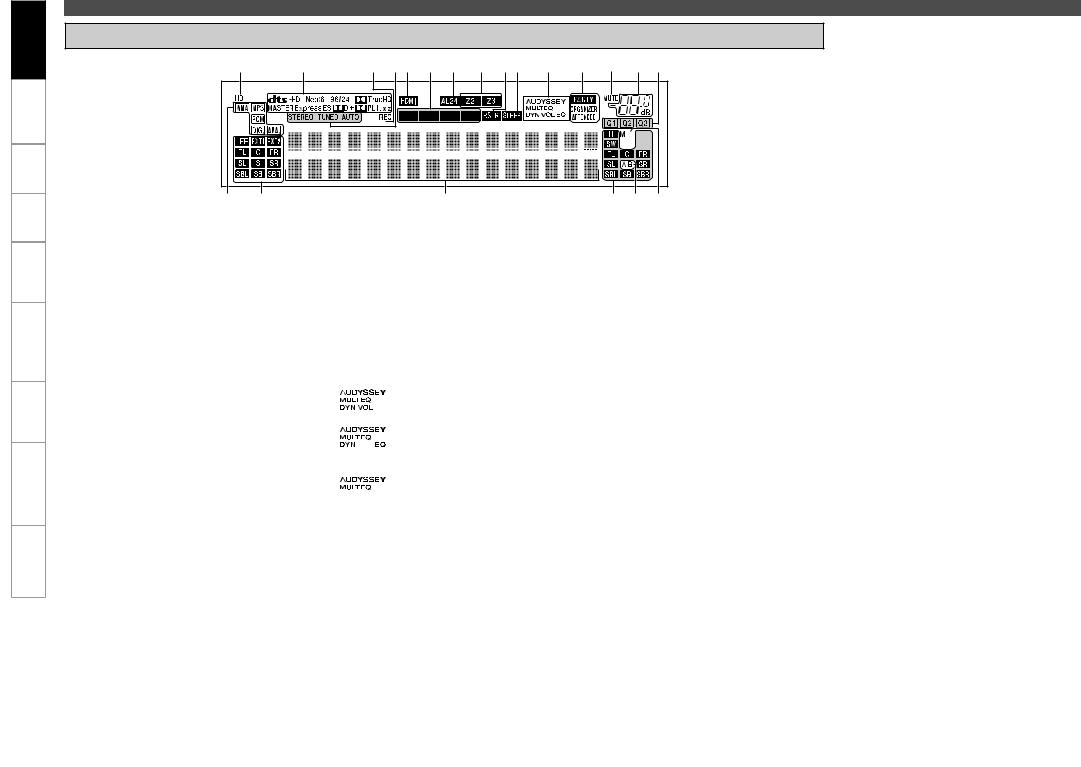
Specifications Troubleshooting Information Control Remote zone-Multi Playback Settings Connections Started Getting
Part Names and Functions
Display
|
W1 |
W0 |
Q9Q8Q7Q6Q5 Q4Q3Q2 Q1 Q0 o i u |
|
q |
w |
|
e |
r t y |
qInput signal indicators
wInput signal channel indicators
These light when digital signals are input. When playing HD Audio sources, the“ ” indicator lights when an extension channel (a channel other than the front, center, surround, surround back or LFE channel) is input. If there are two or more extension channels, the “
” indicator lights when an extension channel (a channel other than the front, center, surround, surround back or LFE channel) is input. If there are two or more extension channels, the “ ” and “
” and “ ” indicators light.
” indicators light.
eInformation display
The input source name, surround mode, setting values and other information are displayed here.
rOutput signal channel indicators
tFront speaker indicators
These light according to the settings of the front A and B speakers.
yMonitor output indicators
This indicator lights up when an HDMI monitor is connected.
uQUICK SELECT indicators iMaster volume indicator
oMUTE indicator
This lights when the mute mode is selected.
Q0PARTY indicators
These indicators light during party mode.
•ORGANIZER
This lights to indicate that party mode has started as Organizer.
•ATTENDEE
This lights to indicate that party mode has started as Attendee.
Q1AUDYSSEY MULTEQ indicators
Lighting is as follows, depending on the setting of “Dynamic EQ” (vpage 73) and “Dynamic Volume” (vpage 74).
• |
|
: When“DynamicEQ”and“Dynamic |
|
|
Volume” are “ON”. |
|
|
|
• |
|
: When the “Dynamic EQ” setting is |
|
||
|
|
“ON” and the “Dynamic Volume” |
|
|
|
|
|
setting is “OFF”. |
• |
|
: When“DynamicEQ”and“Dynamic |
|
||
|
|
Volume” are “OFF”. |
|
|
Q2SLEEP indicator
This lights when the sleep mode is selected.
Q3RESTORER indicator
This lights when the RESTORER mode is selected.
Q4Multi zone indicators
These light when the power for the respective zone is turned on.
Q5AL24 indicator
This lights when AL24 Processing Plus (vpage 94) is activated.
Q6Input mode indicators
Q7HDMI indicator
This lights when playing using HDMI connections.
Q8Tuner reception mode indicators
These light according to the reception conditions when the input source is set to “HD Radio”.
•STEREO
In the FM mode, these light when receiving analog stereo broadcasts.
•TUNED
Lights when the broadcast is properly tuned in.
•AUTO
These light when in the auto tuning mode.
Q9Recording output source indicator
This lights when the REC OUT mode is selected.
W0Decoder indicators
These light when the respective decoders are operating.
W1HD indicator
This lights during HD Radio reception.
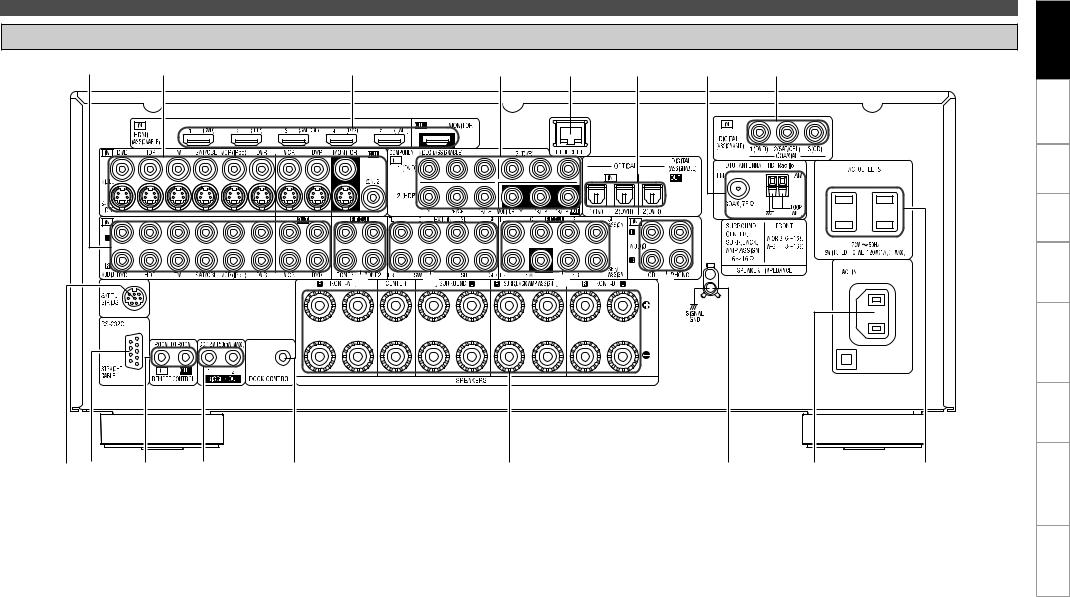
Part Names and Functions
Rear Panel
Q6 |
Q5 |
Q4 |
Q3 |
Q2 |
Q0 |
Q1 |
Q0 |
|
|
|
Q7 |
Q8 |
Q7 |
Q6 |
|
|
q w |
e |
r |
t |
y |
|
u |
i |
o |
qSIRIUS connector········································ (19) wRS-232C connector····································· (22) eREMOTE CONTROL jacks··························· (22) rTRIGGER OUT jacks···································· (22) tDOCK CONTROL jack·································· (16) ySpeaker terminals······································· (13)
uSIGNAL GND terminal································ (17) iAC inlet························································ (24) oAC OUTLETS··············································· (24) Q0Digital audio connectors···················· (16 ~ 19) Q1HD Radio antenna terminals······················ (20) Q2ETHERNET connector································· (23)
Q3COMPONENT VIDEO connectors···(15, 16, 18)
Q4HDMI connectors········································ (14)
Q5VIDEO / S-VIDEO connectors············· (15 ~ 19)
Q6Analog audio connectors··················· (16 ~ 19)
Q7PRE OUT connectors···························· (22, 84)
Q8EXT. IN connectors····································· (21)
Specifications Troubleshooting Information Control Remote zone-Multi Playback Settings Connections Started Getting
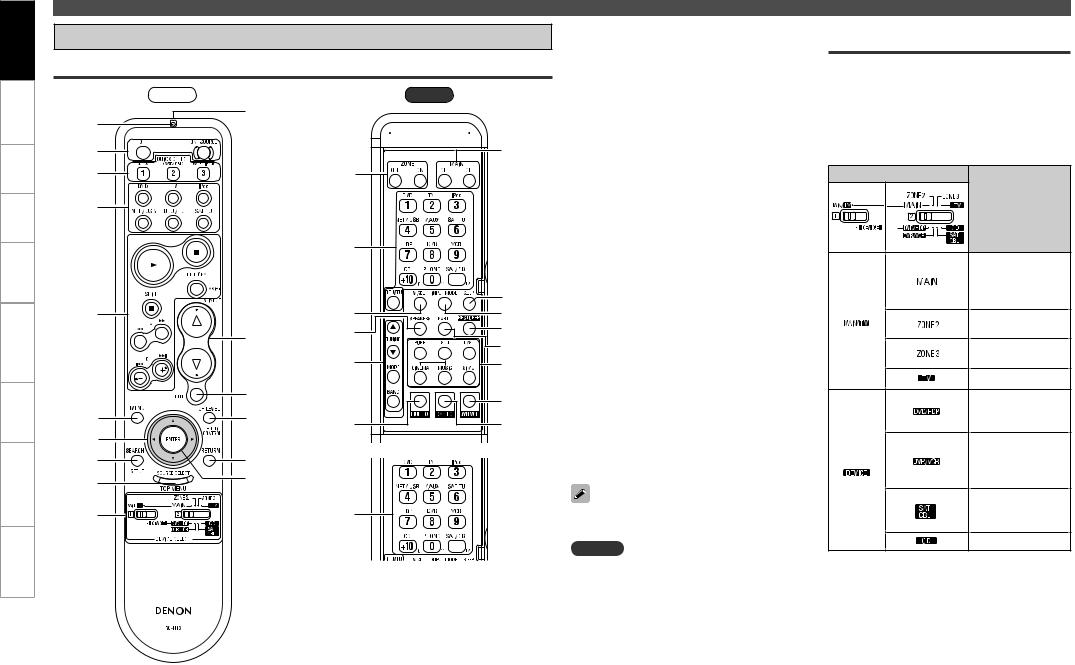
Specifications Troubleshooting Information Control Remote zone-Multi Playback Settings Connections Started Getting
Part Names and Functions
Remote Control Unit
Main Remote Control Unit (RC-1118)
Front |
Rear |
|
Q1 |
q |
|
w |
W3 |
e |
Q7 |
r |
|
|
r |
|
|
|
W4 |
t |
|
Q8 |
W5 |
|
Q2 |
Q9 |
W6 |
|
|
||
|
|
W7 |
|
|
|
|
|
|
|
W0 |
W8 |
|
Q3 |
|
W9 |
|
|
|
|
y |
Q4 |
W1 |
E0 |
|
|
||
u |
|
|
|
i |
Q5 |
|
|
o |
Q6 |
|
|
|
|
|
|
Q0 |
|
W2 |
|
qIndicator······················································· (86) |
Operations possible by remote |
|
wPower buttons············································· (24) |
control |
|
eQUICK SELECT buttons······························ (80) |
n Operations on the AVR-3310CI |
|
rInput source select button························· (27) |
n Operations on five devices other that |
|
tSystem buttons······················· (67, 68, 87 ~ 90) |
||
yMENU button·············································· (25) |
the AVR-3310CI |
|
• Preset the remote control codes of the devices |
||
uCursor buttons (uio p)·························· (26) |
||
to be operated (vpage 86). |
||
iSEARCH button··········································· (68) |
||
• Switch two device selector switches according |
||
oSOURCE SELECT button···························· (27) |
||
to the devices to be operated. |
||
Q0DEVICE SELECT switches·······················(7, 86) |
Position of switches |
|
Q1Remote control signal transmitter·············· (3) |
||
|
||
Q2Master volume control buttons················· (67) |
|
|
Q3Muting button (MUTE)······························· (67) |
Operable devices |
|
Q4Channel level adjustment button········ (35, 79) |
|
|
Q5RETURN button··········································· (26) |
|
|
Q6ENTER button·············································· (26) |
AVR-3310CI |
|
Q7ZONE power button··································· (85) |
||
(MAIN ZONE) |
||
Q8VIDEO SELECT button································ (48) |
iPod, DTU, SAT TU, |
|
Q9Front height speaker on/off button·········· (72) |
NET/USB |
|
W0Tuner operation buttons···························· (57) |
AVR-3310CI |
|
W1MULTEQ® button······································· (73) |
(ZONE2) |
|
W2Number buttons (0 ~ 9, +10)······················ (86) |
AVR-3310CI |
|
W3MAIN ZONE power buttons······················· (24) |
(ZONE3) |
|
W4SLEEP TIMER button·································· (79) |
TV |
|
W5INPUT MODE button·································· (49) |
Blu-ray disc player |
|
W6RESTORER button·······································(74) |
||
or |
||
W7PARTY button·············································· (80) |
DVD Player |
|
W8Surround mode buttons······················· (69, 70) |
Digital video |
|
W9DYNAMIC VOLUME™ button·····················(74) |
recorder |
|
E0DYNAMIC EQ™ button······························· (73) |
or |
|
|
Video deck |
|
|
Satellite receiver |
|
For buttons not explained here, see the page |
or |
|
indicated in parentheses ( ). |
Cable TV |
|
NOTE |
CD player |
|
|
Buttons on the back panel may operate when the |
n Multi-zone (ZONE2 / ZONE3) |
back lid is pressed. |
operations (vpage 84) |
n Punch through setting (vpage 90)

Sub Remote Control Unit (RC-1121)
|
Q1 |
q |
Q2 |
|
Q3 |
|
Q4 |
w |
|
e |
|
|
Q5 |
r |
|
t |
Q6 |
 Q7 y
Q7 y



 Q8
Q8 
 Q9
Q9
u



i |
W0 |
|
W1 |
o |
|
Q0 |
W2 |
|
|
|
W3 |
qZONE indicators·········································· (92) wQUICK SELECT buttons························ (80, 86) eInput source select buttons······················· (91) rSHIFT button··············································· (91) tChannel button (CH)··································· (91) yMENU button········································ (25, 91) uCursor buttons (uio p)····················· (26, 91) iSEARCH button····································· (68, 91) oREPEAT button······································ (68, 91) Q0RANDOM button··································· (68, 91)
Q1Remote control signal transmitter·············· (3)
Q2ZONE SELECT button································· (92)
Q3Zone power on/off buttons························ (85)
Q4Advanced setup button······························ (92)
Q5MAIN ZONE call button······························ (92)
Q6Master volume control buttons (VOL)······ (85)
Q7Muting button (MUTE)······························· (85)
Q8MEMORY button········································· (91)
Q9ENTER button········································ (26, 91)
W0RETURN button····································· (26, 91)
W1System buttons··········································· (91)
W2ALL MUSIC/FAVORITES
(DIRECT PLAY) button································ (91) W3USB (DIRECT PLAY) button················· (63, 91)
Part Names and Functions
Specifications Troubleshooting Information Control Remote zone-Multi Playback Settings Connections Started Getting
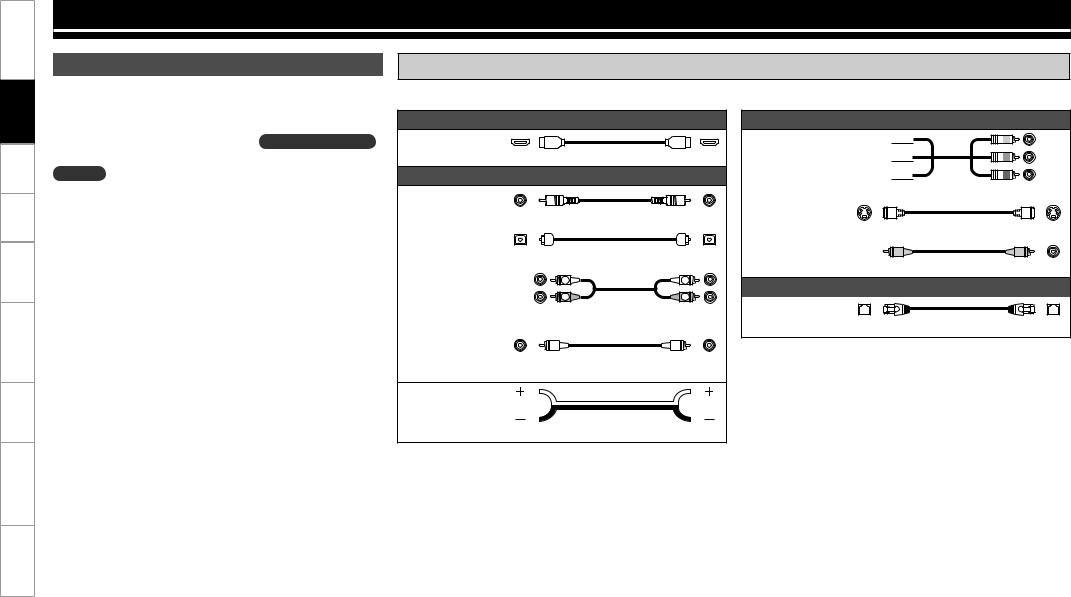
Specifications Troubleshooting Information Control Remote zone-Multi Playback Settings Connections Started Getting
Connections
Important Information
Connections for all compatible audio and video signal formats are described in this owner’s manual. Please select the types of connections suited for the equipment you are connecting.
After connections are completed, certain settings must be made on
the receiver. Make the settings indicated “ Set as Necessary ” for the individual items.
NOTE
•Do not plug in the power cord until all connections have been completed.
•When making connections, also refer to the operating instructions of the other components.
•Be sure to connect the left and right channels properly (left with left, right with right).
•Do not bundle power cords together with connection cables. Doing so can result in humming or noise.
Cables Used for Connections
Select the cables (sold separately) according to the equipment being connected.
Audio and video cables
HDMI connections
|
|
HDMI cable |
|
|
|
Audio cables |
|
||
Coaxial digital |
|
|
|
|
connections |
|
Coaxial digital cable |
|
|
|
|
|
||
Optical digital |
|
|
|
|
connections |
|
Optical cable |
|
|
|
|
|
||
Analog |
(White) |
L |
L |
|
connections |
||||
(Red) |
R |
R |
||
(stereo, surround) |
||||
|
|
|
||
|
|
Audio cable |
|
|
Analog |
|
|
|
|
connections |
|
|
|
|
(monaural, for |
|
Audio cable |
|
|
subwoofer) |
|
|
||
|
|
|
||
Speaker |
|
|
|
|
connections |
|
|
|
|
|
|
Speaker cables |
|
|
Video cables
Component video connections
S-Video connections
Video connections
(Green) 




 (Blue)
(Blue) 

 (Red)
(Red) 


Component video cable
S-Video cable
(Yellow) 
Video cable
|
Other cables |
Network |
|
connections |
Ethernet cable |
|
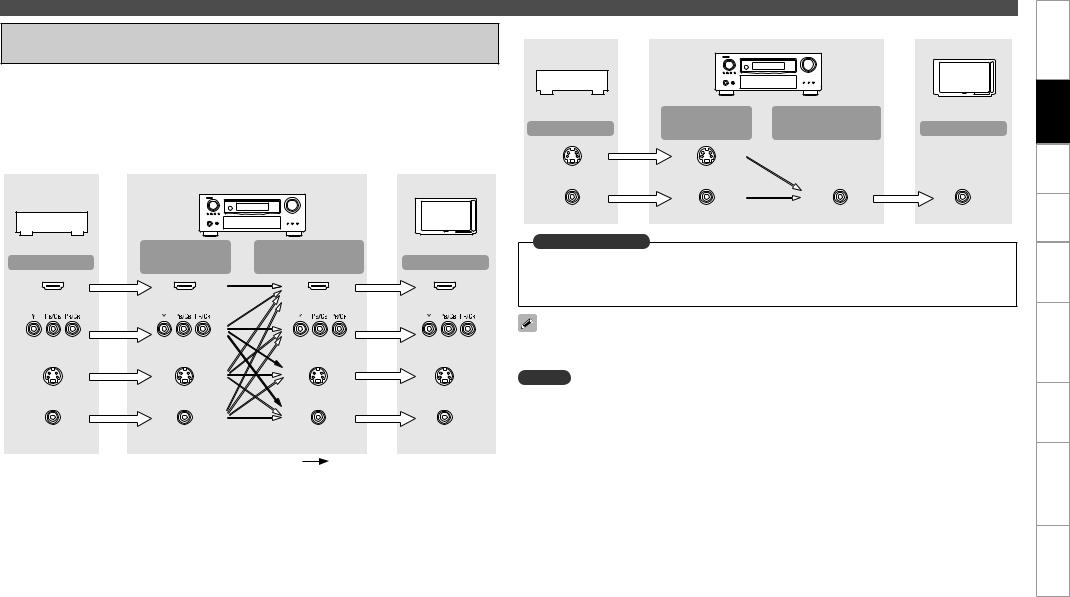
Converting Input Video Signals for Output (Video Conversion Function)
The AVR-3310CI has 4 different types of video input/output terminal (HDMI, Component video, S-Video, Video).
Use the terminals according to the devices to be connected.
This function automatically converts various formats of video signals input to the AVR-3310CI into the format used to output the video signals from the AVR-3310CI to a monitor. (vpage 99 “Relationship Between Video Signals and Monitor Output”).
GFlow of video signals for MAIN ZONEH
|
AVR-3310CI |
Monitor |
|
Video device |
|
|
|
|
|
|
|
Output |
Input |
Output |
Input |
(IN) |
(MONITOR OUT) |
||
HDMI connector |
HDMI connector |
HDMI connector |
HDMI connector |
Component video |
Component video |
Component video |
Component video |
connectors |
connectors |
connectors |
connectors |
S-Video connector |
S-Video connector |
S-Video connector |
S-Video connector |
Video connector |
Video connector |
Video connector |
Video connector |
|
|
: When 480i/576i signals are input |
|
Important Information
|
GFlow of video signals for ZONE2H |
|
|
|
AVR-3310CI |
Monitor |
|
Video device |
|
|
|
|
|
|
|
Output |
Input |
Output |
Input |
(IN) |
(MONITOR OUT) |
||
S-Video connector |
S-Video connector |
|
|
Video connector |
Video connector |
Video connector |
Video connector |
Set as Necessary
•Set when using the video conversion function.
“Video Convert” (vpage 48)
•Set when changing the resolution of the video signal.
“Resolution” (vpage 48)
Resolutions of HDMI-compatible TVs can be checked at “HDMI Information” – “Monitor Information” (vpage 76).
NOTE
•HDMI signals cannot be converted into analog signals.
•When a non-standard video signal from a game machine or some other source is input, the video conversion function might not operate.
•480p/576p/1080i/720p/1080p component video input signals cannot be converted into S-Video or Video format.
Specifications Troubleshooting Information Control Remote zone-Multi Playback Settings Connections Started Getting
10

Specifications Troubleshooting Information Control Remote zone-Multi Playback Settings Connections Started Getting
Installing / Setting the Speakers
•The AVR-3310CI is compatible with various types of surround playback.
•Decide on the surround modes to be played on the AVR-3310CI before making connections and settings.
a Determine the Speaker Layout
Below we introduce examples of speaker layouts. Refer to these to arrange your speakers according to their type and how you want to use them.
Installing All the Speakers
Front Height speakers
n When 7.1ch (Front Height Speaker) Connected
Front height speakers |
|
|
||
Front speakers |
|
|
||
Center speaker |
z1: 22˚ ~ 30˚ |
|
||
z2: 22˚ ~ 45˚ |
|
|||
|
|
|
z3: 90˚ ~ 110˚ |
|
Subwoofer |
Monitor |
Point slightly |
|
|
|
|
|
|
|
2 |
|
z |
downwards |
|
|
|
|
||
z |
|
|
|
|
|
1 |
3 |
Front height |
Surround |
z |
|
speaker |
||
|
|
|
speaker |
|
|
|
|
Front speaker |
2 to 3 feet / |
|
|
|
|
|
|
|
|
|
60 to 90 cm |
Surround speakers |
|
|
||
|
|
|
|
GAs seen from aboveH |
GAs seen from the sideH |
|
Front speakers |
|
n When 7.1ch (Surround Back Speaker) Connected |
||
|
|
||||
|
|
|
|
||
|
|
|
|||
|
|
|
|
|
|
|
|
|
|
Front speakers |
|
|
|
|||
|
|
|
|
Center speaker |
z1: 22 ~ 30˚ |
|
|
|||
Subwoofer |
Center speaker |
|
|
|
Monitor |
z2: 90˚ ~ 110˚ |
|
|
||
|
|
|
|
z3: 135˚ ~ 150˚ |
|
|
||||
|
|
|
|
Subwoofer |
|
|
|
|||
|
|
|
|
|
|
1 |
|
|
|
|
|
|
|
|
|
|
z |
|
|
|
|
|
|
|
|
|
|
z |
|
|
|
|
|
|
|
|
z |
3 |
2 |
Surround |
Surround back |
||
|
|
|
|
|
||||||
|
|
|
|
|
|
|||||
|
|
|
|
|
|
|
speaker |
speaker |
||
|
|
|
|
|
|
|
Front |
|
|
|
|
|
|
|
|
|
|
speaker 2 to 3 feet / |
|
||
Surround |
Surround back speakers |
Surround |
Surround speakers |
60 to 90 cm |
Point slightly |
|||||
speaker |
|
|
speaker |
|
|
downwards |
||||
|
|
Surround back |
|
|
|
|||||
|
|
|
|
|
|
|
||||
NOTE |
|
|
|
|
|
speakers |
|
|
|
|
|
|
|
GAs seen from aboveH |
GAs seen from the sideH |
||||||
It is not possible to use the surround back speakers and |
||||||||||
|
|
|
|
|
|
|||||
front height speakers simultaneously. |
|
|
|
|
|
|
|
|||
n When 6.1ch (Surround Back Speaker) Connected
Front speakers |
|
|
|
|
Center speaker |
z1: 22 ~ 30˚ |
|
|
|
Monitor |
z2: 90˚ ~ 110˚ |
|
|
|
Subwoofer |
|
|
|
|
1 |
|
|
|
|
z |
|
|
|
|
z |
|
|
|
|
2 |
Surround |
Surround back |
||
|
||||
|
speaker |
speaker |
||
|
Front |
|
|
|
Surround speakers |
speaker |
2 to 3 feet / |
Point slightly |
|
|
60 to 90 cm |
|||
|
|
|
|
downwards |
Surround back |
|
|
|
|
speaker |
|
|
|
|
GAs seen from aboveH |
GAs seen from the sideH |
|||
n When 5.1ch Connected |
|
|
|
|
Front speakers |
z1: 22 ~ 30˚ |
|
|
|
Center speaker |
|
|
||
Monitor |
z2: 120˚ |
|
|
|
|
|
|
||
Subwoofer |
|
|
|
|
1 |
|
|
|
|
z |
|
|
|
|
2 |
|
|
|
|
z |
|
Surround |
|
|
|
Front |
speaker |
|
|
|
|
|
|
|
|
speaker |
2 to 3 feet / |
||
|
|
|||
|
|
60 to 90 cm |
||
Surround speakers |
|
|
|
|
GAs seen from aboveH |
GAs seen from the sideH |
|||
11

Installing/Setting the Speakers
s Set the “Amp Assign” Mode According to the Speaker Layout
The signals output from the AVR-3310CI’s SURR. BACK/AMP ASSIGN speaker terminals can be switched (vpage 34 “Amp Assign”).
Amp assign |
SURR. BACK / |
|
Example of speaker installation |
||||||||
mode |
AMP ASSIGN |
|
|||||||||
|
(Number of channels played) |
||||||||||
(vpage 34) |
Speaker connections |
||||||||||
|
|
|
|
|
|
|
|||||
|
|
|
|
|
|
|
|
|
|
|
|
Normal |
Surround Back |
|
|
|
|
|
|
|
|
||
|
|
|
|
|
|
|
|
|
|||
|
Speakers |
|
|
|
|
|
|
|
|
||
|
|
|
|
|
|
|
|
|
|
|
|
|
|
|
|
|
|
|
(7.1) |
|
|
|
|
|
|
|
|
|
|
|
|
|
|
|
|
|
Surround Back L |
|
|
|
|
|
|
|
|
||
|
Speaker |
|
|
|
|
|
|
|
|
||
Normal |
b Connect to |
the |
“L” |
|
|
|
|
|
|
|
|
speaker terminal. |
|
|
|
|
|
|
|
|
|||
|
|
|
|
|
|
|
|
|
|||
|
b Set “Surround Back” |
|
|
|
|
|
|
|
|||
|
(vpage |
34) |
to |
|
|
|
(6.1) |
|
|
|
|
|
“1spkr”. |
|
|
|
|
|
|
|
|
|
|
|
|
|
|
|
|
|
|
|
|
||
|
Not connected |
|
|
|
|
|
|
|
|
||
Normal |
b Set “Surround Back” |
|
|
|
|
|
|
|
|||
|
(vpage 34) to |
|
|
|
|
|
|
|
|
||
|
“None”. |
|
|
|
|
|
|
|
|
|
|
|
|
|
|
|
|
(5.1) |
|
|
|
||
|
|
|
|
|
|
|
|
|
|
||
|
|
|
|
|
|
|
|
|
|
|
|
|
|
|
|
MAIN ZONE |
ZONE2 |
||||||
ZONE2 |
ZONE2 speakers |
|
|
|
|
|
|
|
|
||
(Default) |
|
|
|
|
|
|
|
|
|||
|
|
|
|
|
|
|
|
|
|
||
|
|
|
|
|
|
|
|
|
|
||
|
|
|
|
|
(5.1) |
|
(2) |
||||
|
|
|
|
|
|
|
|
|
|
|
|
|
|
|
|
MAIN ZONE |
ZONE3 |
||||||
Amp assign |
SURR. BACK / |
Example of speaker installation |
||
mode |
AMP ASSIGN |
|||
(Number of channels played) |
||||
(vpage 34) |
Speaker connections |
|||
|
|
|||
|
|
|
|
|
|
|
MAIN ZONE |
ZONE2 or ZONE3 |
|
ZONE2/3-MONO L ch : ZONE2 speaker
R ch : ZONE3 speaker
(5.1) (1)
Front A Bi-Amp
or
Front B Bi-Amp
Front A or B speakers
b For |
connections, |
|
see “About Bi-amp |
|
|
Connections” (vpage |
|
|
(5.1) |
||
13). |
|
|
Front Height |
Front height |
|
Speakers |
||
|
(7.1)
ZONE3 |
ZONE3 speakers |
(5.1) (2)
Specifications Troubleshooting Information Control Remote zone-Multi Playback Settings Connections Started Getting
12

Specifications Troubleshooting Information Control Remote zone-Multi Playback Settings Connections Started Getting
Speaker Connections |
|
|
|
|
|
|||||
|
Front |
Center |
|
Surround |
|
|
Front |
|
||
speakers A |
speaker |
|
speakers |
Subwoofer |
speakers B |
|
||||
|
|
|
|
|
|
|
Subwoofer |
|
|
|
|
|
|
|
|
(L) |
(R) |
with built-in |
|
|
|
(L) |
(R) |
|
|
|
amplifier |
(L) |
(R) |
|
||
w |
q w |
q |
|
w |
qw |
|
q |
w |
q w |
q |
|
|
w |
q |
|
|
|
|
|||
|
|
|
|
|
*/ |
|
|
|
||
|
|
|
|
|
|
|
|
|
|
|
For connections of the SURR. BACK/AMP ASSIGN speaker terminals, see “Set the “Amp Assign” Mode According to the Speaker Layout” (vpage 12).
Protection Circuit
If the core wires touch the rear panel and the screws etc., or the ± sides touch each other, the protection circuit will be activated and the power indicator will flash red at intervals of 0.5 secs.
If the protection circuit is activated, the speaker output is isolated, and the power supply goes to the standby state. If the power supply is turned off, after the power supply cord is withdrawn, please confirm that speaker cable and input cable are connected.
Also, if replaying large sound levels by using a speaker having an impedance less than that specified (eg, 4 Ω/ohms), the temperature will rise, and the protection circuit might be activated. The power supply will go into the standby state, and the power indicator will flash red at 2 second intervals.
In this case, please switch off the power supply, and wait until the AVR-3310CI has cooled down, and the surrounding ventilation is good.
Even if there are no problems with the surrounding ventilation and connections, in the event of the protection circuit becoming activated, due to thinking that the AVR-3310CI has failed, please contact DENON Service center after switching off.
13
Connecting the Speaker
Cables
Carefully check the left (L) and right (R) channels and + (red) and – (black) polarities on the speakers being connected to the AVR-3310CI, and be sure to interconnect the channels and polarities correctly.
1Peel off about 0.03 ft/10 mm of sheathing from the tip of the speaker cable, then either twist
the core wire tightly or terminate it.
2Turnthespeakerterminal counterclockwise to loosen it.
3Insert the speaker cable’s core wire to the hilt into the speaker terminal.
4Turnthespeakerterminal
clockwise to tighten it.
n When using a banana plug
Tighten the speaker terminal firmly before inserting the banana plug.
Use speakers with an impedance of 6 to 16 Ω/ohms. When using front A and B speakers simultaneously, use speakers with an impedance of 8 to 16 Ω/ ohms.
NOTE
•Connect so that the speaker cable core wires do not protrude from the speaker terminal. The protection circuit may be activated if the core wires touch the rear panel or if the + and – sides touch each other (v“Protection Circuit”).
•Never touch the speaker terminals while the power supply is connected. Doing so could result in electric shock.
About Bi-amp Connections
These connections make for higher quality playback sound with no interference between the signals of the bass and treble units.
When the “Amp Assign” setting (vpage 34) is “Front A Bi-Amp” or “Front B Bi-Amp”, connect as follows. (The illustration shows a connection example for the Front A Bi-Amp speakers.)
Front speakers A
q w |
q w |
(L)(R)
AVR-3310CI |
When in the “Front A Bi-Amp” and “Front B BiAmp” modes, the same signals are output from the front speaker terminals and the AMP ASSIGN terminals.
NOTE
•Use speakers compatible with bi-amp connections.
•When making bi-amp connections, be sure to remove the short-circuiting plate or wire between the speaker’s woofer and tweeter terminals.

Connecting Devices
Connecting Devices
nConnecting Devices Equipped with HDMI Terminals (vpage 14)
n Connecting the Monitor (vpage 15)
nConnecting the Playback Components
•Blu-ray Disc Player / DVD Player (vpage 16)
•Control dock for iPod (vpage 16)
•CD Player (vpage 17)
•Record Player (vpage 17)
nConnecting the Recording Components
•Video Cassette Recorder (vpage 17)
•Digital Video Recorder (vpage 18)
nConnect the Tuner
•TV (vpage 18)
•Satellite Receiver / Cable Tuner (vpage 19)
•SIRIUS (vpage 19)
•HD Radio (vpage 20)
nConnections to Other Devices
•Video Camera / Game Console (vpage 21)
•USB Port (vpage 21)
•Component with Multi-channel Output connectors (vpage 21)
•External Power Amplifier (vpage 22)
•External Controller (vpage 22)
n Connecting to a Home Network (LAN) (vpage 23)
Connecting Devices Equipped with HDMI Terminals
Important Information
n About HDMI
“HDMI” is the abbreviation of “High Definition Multimedia Interface”. This interface allows transfer of digital video signals and digital audio signals over a single HDMI cable.
“HDMI”, “HDMI logo” and “High-Definition Multimedia Interface” are trademarks or registered trademarks of HDMI Licensing LLC.
n Functions Usable with HDMI Connections
Deep Color
Eliminates on-screen color banding, for smooth tonal transitions and subtle gradations between colors. Enables increased contrast ratio.
x.v.Color
Lets HDTVs display colors more accurately. Enables displays with natural, vivid colors. “x.v.Color” is a Sony registered trademark.
Auto Lip Sync (vpage 36)
If you connect the receiver to a TV that supports the Auto Lip Sync function, it can automatically correct delay between the audio and video.
HDMI Control Function (vpage 78)
This function allows you to operate external devices from the receiver and operate the receiver from external devices.
NOTE
•These functions will not work if the device connected to the HDMI terminal does not support Deep Color or x.v.Color signal transfer or the Auto Lip Sync function.
•The HDMI control function may not work depending on the device it is connected to and its settings.
•You cannot operate a TV or Blu-ray Disc player / DVD player that is not compatible with the HDMI control function.
n Copyright Protection System (HDCP)
The AVR-3310CI supports HDCP (High-bandwidth Digital Contents Protection). HDCP is a copyright protection technology for digital video signals. The devices connected to the AVR-3310CI must also support HDCP.
NOTE
When a device that does not support HDCP is connected, video signals are not properly output.
Connections
The AVR-3310CI allows connection of inputs from up to 5 HDMI devices and output to 1 monitor.
|
|
|
|
|
|
|
|
|
|
|
|
|
|
|
|
|
|
|
|
|
|
|
|
|
|
|
|
|
|
|
|
|
|
|
|
Digital |
|
|
|
|
|
|
|
|
|
|
|
|
|
|
|
||||||||
|
|
|
|
|
|
|
|
|
|
|
|
|
|
|
|
|
|
|
|
|
|
|
|
|
|
|
|
|
|
|
|
|
|
|
|
|
|
|
|
|
|
|
|
|
|
|
|
|
|||||||||||
|
DVD |
|
|
|
|
|
|
|
|
|
|
|
|
|
|
|
|
Satellite |
|
|
|
|
|
|
|
|
Game |
|
|
|
|
||||||||||||||||||||||||||||
|
|
|
|
|
|
|
|
|
|
|
|
|
|
|
|
|
|
|
|
|
|
video |
|
|
|
|
|
|
|
|
|||||||||||||||||||||||||||||
|
|
|
HD player |
|
|
|
|
|
|
|
|
|
|
|
|
|
|
|
|||||||||||||||||||||||||||||||||||||||||
|
player |
|
|
|
|
|
receiver |
|
|
|
|
|
|
|
|
console |
|
|
|
|
|||||||||||||||||||||||||||||||||||||||
|
|
|
|
|
|
|
|
|
|
|
recorder |
|
|
|
|
|
|
|
|||||||||||||||||||||||||||||||||||||||||
|
|
|
|
|
|
|
|
|
|
|
|
|
|
|
|
|
|
|
|
|
|
|
|
|
|
|
|
||||||||||||||||||||||||||||||||
|
|
|
|
|
|
|
|
|
|
|
|
|
|
|
|
|
|
|
|
|
|
|
|
|
|
|
|
|
|
|
|
|
|
|
|
|
|
|
|
|
|
|
|
|
|
|
|
|
|
||||||||||
|
|
|
|
|
|
|
|
|
|
|
|
|
|
|
|
|
|
|
|
|
|
|
|
|
|
|
|
|
|
|
|
|
|
|
|
|
|
|
|
|
|
|
|
|
|
|
|
|
|||||||||||
|
|
|
|
|
|
|
|
|
|
|
|
|
|
|
|
|
|
|
|
|
|
|
|
|
|
|
|
|
|
||||||||||||||||||||||||||||||
|
)%.* |
|
)%.* |
|
|
)%.* |
|
|
|
|
|
)%.* |
|
|
|
|
|
|
)%.* |
|
|
|
|
|
|
|
|
||||||||||||||||||||||||||||||||
|
065 |
|
065 |
|
|
|
065 |
|
|
|
|
|
065 |
|
|
|
|
|
|
065 |
|
|
|
|
|
|
|
|
|||||||||||||||||||||||||||||||
|
|
|
|
|
|
|
|
|
|
|
|
|
|
|
|
|
|
|
|
|
|
|
|
|
|
|
|
|
|
|
|
|
|
|
|
|
|
|
|
|
|
|
|
|
|
|
|
|
|
|
|
|
|
|
|
|
|
|
|
|
|
|
|
|
|
|
|
|
|
|
|
|
|
|
|
|
|
|
|
|
|
|
|
|
|
|
|
|
|
|
|
|
|
|
|
|
|
|
|
|
|
|
|
|
|
|
|
|
|
|
|
|
|
|
|
|
|
|
|
|
|
|
|
|
|
|
|
|
|
|
|
|
|
|
|
|
|
|
|
|
|
|
|
|
|
|
|
|
|
|
|
|
|
|
|
|
|
|
|
|
|
|
|
|
|
|
|
|
|
|
|
|
|
|
|
|
|
|
|
|
|
|
|
|
|
|
|
|
|
|
|
|
|
|
|
|
|
|
|
|
|
|
|
|
|
|
|
|
|
|
|
|
|
|
|
|
|
|
|
|
|
|
|
|
|
|
|
|
|
|
|
|
|
|
|
|
|
|
|
|
|
|
|
|
|
|
|
|
|
|
|
|
|
|
|
|
|
|
|
|
|
|
|
|
|
|
|
|
|
|
|
|
|
|
|
|
|
|
|
|
|
|
|
|
|
|
|
|
|
|
|
|
|
|
|
|
|
|
|
|
|
|
|
|
|
|
|
|
|
|
|
|
|
|
|
|
|
|
|
|
|
|
|
|
|
|
|
|
|
|
|
|
|
|
|
|
|
|
|
|
|
|
|
|
|
|
|
|
|
|
|
|
|
|
|
|
|
|
|
|
|
|
|
|
|
|
|
|
|
|
|
|
|
|
|
|
|
|
|
|
|
|
|
|
|
|
|
|
|
|
|
|
|
|
|
|
|
|
|
|
|
|
|
|
|
|
|
|
|
|
|
|
|
|
|
|
|
|
|
|
|
|
|
|
|
|
|
|
|
|
|
|
|
|
|
|
|
|
|
|
|
|
|
|
|
|
|
|
|
|
|
|
|
|
|
|
|
|
|
|
|
|
|
|
|
|
|
|
|
|
|
|
|
|
|
|
|
|
|
|
|
|
|
|
|
|
|
|
|
|
|
|
|
|
|
|
|
|
|
|
|
|
|
|
|
|
|
|
|
|
|
|
|
|
|
|
|
|
|
|
|
|
|
|
|
|
|
|
|
|
|
|
|
|
|
|
|
|
|
|
|
|
|
|
|
|
|
|
|
|
|
|
|
|
|
|
|
|
|
|
|
|
|
|
|
|
|
|
|
|
|
|
|
|
|
|
|
|
|
|
|
|
|
|
|
|
|
|
|
|
|
|
|
|
|
|
|
|
|
|
|
|
|
|
|
|
|
|
|
|
|
|
|
|
|
|
|
|
|
|
|
|
|
|
|
|
|
|
|
|
|
|
|
|
|
|
|
|
|
|
|
|
|
|
|
|
|
|
|
|
|
|
|
|
|
|
|
|
|
|
|
|
|
|
|
|
|
|
|
|
|
|
|
|
|
|
|
|
|
|
|
|
|
|
|
|
|
|
|
|
|
|
|
|
|
|
|
|
|
|
|
|
|
|
|
|
|
|
|
|
|
|
|
|
|
|
|
|
|
|
|
|
|
|
|
|
|
|
|
|
|
|
|
|
|
|
|
|
|
|
|
|
|
|
|
|
|
|
|
|
|
|
|
|
|
|
|
|
|
|
|
|
|
|
|
|
|
|
|
|
|
|
|
|
|
|
|
|
|
|
|
|
|
|
|
|
|
|
|
|
|
|
|
|
|
|
|
|
|
|
|
|
|
|
|
|
|
|
|
|
|
|
|
|
|
|
|
|
|
|
|
|
|
|
|
|
|
|
|
|
|
|
|
|
|
|
|
|
|
|
|
|
|
|
|
|
|
|
|
|
|
|
|
|
|
|
|
|
|
|
|
|
|
|
|
|
|
|
|
|
|
|
|
|
|
|
|
|
|
|
|
|
|
|
|
|
|
|
|
|
|
|
|
|
|
|
|
|
|
|
|
|
|
|
|
|
|
|
|
|
|
|
|
|
|
|
|
|
|
|
|
|
|
|
|
|
|
|
|
|
|
|
|
|
|
|
|
|
|
|
|
|
|
|
|
|
|
|
|
|
|
|
|
|
|
|
|
|
|
|
|
|
|
|
|
|
|
|
|
|
|
|
|
|
|
|
|
|
|
|
|
|
|
|
|
|
|
|
|
|
|
|
|
|
|
|
|
|
|
|
|
|
|
|
|
|
|
|
|
|
|
|
|
|
|
|
|
|
|
|
|
|
|
|
|
|
|
|
|
|
|
|
|
|
|
|
|
|
|
|
|
|
|
|
|
|
|
|
|
|
|
|
|
|
|
|
|
|
|
|
|
|
|
|
|
|
|
|
|
|
|
|
|
|
|
|
|
|
|
|
|
|
|
|
|
|
|
|
|
|
|
|
|
|
|
|
|
|
|
|
|
|
|
|
|
|
|
|
|
|
|
|
|
|
|
|
|
|
|
|
|
|
|
|
|
|
|
|
|
|
|
|
|
|
|
|
|
|
|
)%.* */
Monitor
•Use a cable on which the HDMI logo is indicated (a certified HDMI product) for connection to the HDMI connector. Normal playback may not be possible when using a cable other than one on which the HDMI logo is indicated (a non-HDMI-certified product).
•When the AVR-3310CI is connected to other devices with HDMI cables, also connect the AVR-3310CI and TV using an HDMI cable.
•When a device supporting Deep Color signal transfer is connected, use a cable compatible with HDMI version 1.3a.
•Video signals are not output if the input video signals do not match the monitor’s resolution. In this case, switch the Blu-ray Disc/ DVD player’s resolution to a resolution with which the monitor is compatible.
Specifications Troubleshooting Information Control Remote zone-Multi Playback Settings Connections Started Getting
14
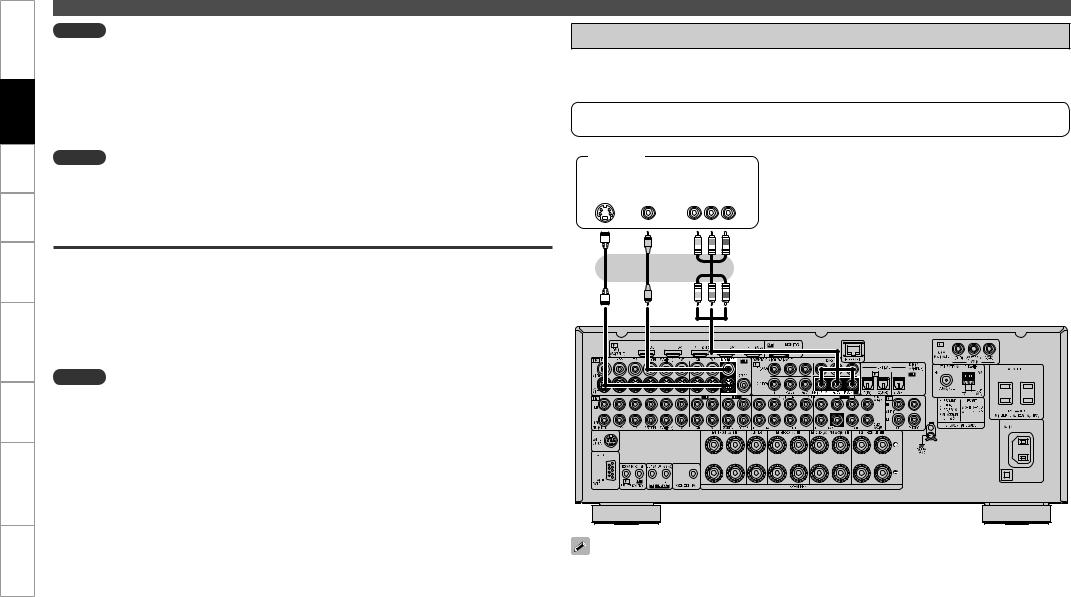
Specifications Troubleshooting Information Control Remote zone-Multi Playback Settings Connections Started Getting
Connecting Devices
NOTE
•If the GUI menu “Audio Out” setting (vpage 36) is set to “AMP”, the sound may be interrupted when the monitor’s power is turned off.
•The audio signal from the HDMI output terminal (sampling frequency, number of channels, etc.) may be limited by the HDMI audio specifications of the connected device regarding permissible inputs.
n Connecting to a Device Equipped with a DVI-D Terminal
When an HDMI/DVI conversion cable (sold separately) is used, the HDMI video signals are converted to DVI signals, allowing connection to a device equipped with a DVI-D terminal.
NOTE
•No sound is output when connected to a device equipped with a DVI-D terminal. Also make the audio connections.
•Signals cannot be output to DVI-D devices that do not support HDCP.
•Depending on the combination of devices, the video signals may not be output.
Connecting the Monitor
•Select the terminal to use and connect the device.
•For video connections, see “Converting Input Video Signals for Output (Video Conversion Function)” (vpage 10).
For instructions on HDMI connections, see “Connecting Devices Equipped with HDMI Terminals” on page 14.
Monitor
|
|
|
7*%&0 |
|
|
||
|
|
|
|
|
|||
|
|
|
|
|
|
|
|
4 7*%&0 |
|
7*%&0 |
|
|
$0.10/&/5 7*%&0 |
||
*/ |
|
*/ |
|
|
|
*/ |
|
|
|
|
|
|
|
: 1# 13 |
|
|
|
|
|
|
|
|
|
Settings Related to HDMI Connections
Set as necessary. For details, see the respective reference pages.
n Input Assign (vpage 45)
Set this to change the HDMI input terminal to which the input source is assigned.
n HDMI Setup (vpage 36)
Make settings for HDMI video/audio output.
• RGB Range
• Auto Lip Sync
NOTE
The audio signals output from the HDMI connectors are only the HDMI input signals.
To listen to TV audio through this device, use the optical digital or analog connection.
15
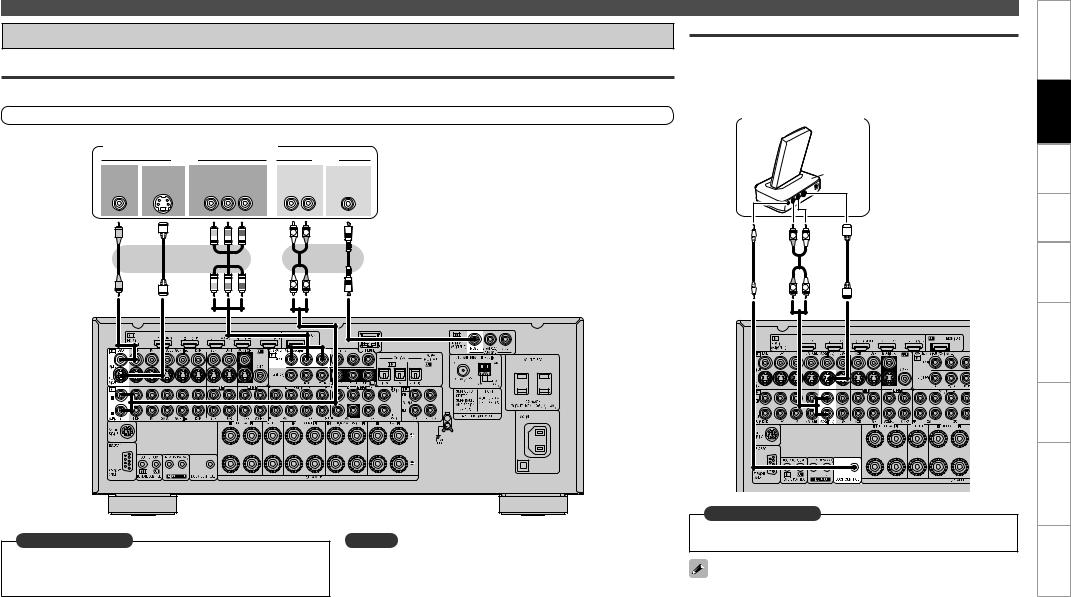
Connecting the Playback Components
Blu-ray Disc Player / DVD Player
Select the terminal to use and connect the device.
For instructions on HDMI connections, see “Connecting Devices Equipped with HDMI Terminals” on page 14.
Blu-ray Disc player / DVD player
|
7*%&0 |
|
|
|
"6%*0 |
7*%&0 |
4 7*%&0 |
$0.10/&/5 7*%&0 |
"6%*0 |
$0"9*"- |
|
065 |
065 |
065 |
065 |
065 |
|
|
|
: 1# 13 |
- |
3 |
|
|
|
|
L |
R |
|
L |
R |
Connecting Devices
Control Dock for iPod
Use a DENON control dock for iPod (ASD-1R or ASD-11R, sold separately) to connect the iPod to the AVR-3310CI. For instructions on the control dock for iPod settings, refer to the control dock for iPod’s operating instructions.
Control dock for iPod
|
"4% 3 |
R |
L |
R |
L |
Set as Necessary
Set this to change the input signal to which the input source is assigned.
“Input Assign” (vpage 45)
NOTE
In the case of HD audio (Dolby TrueHD, DTS-HD and Dolby Digital Plus and DTS Express) audio playback, connect with HDMI (vpage 14, “Connecting Devices Equipped with HDMI Terminals”).
Set as Necessary
Set other than when iPod is assigned to the VCR (iPod) terminal.
“Input Assign” – “iPod dock“ (vpage 47)
With the default settings, the iPod can be used connected to the VCR (iPod) connector.
Specifications Troubleshooting Information Control Remote zone-Multi Playback Settings Connections Started Getting
16
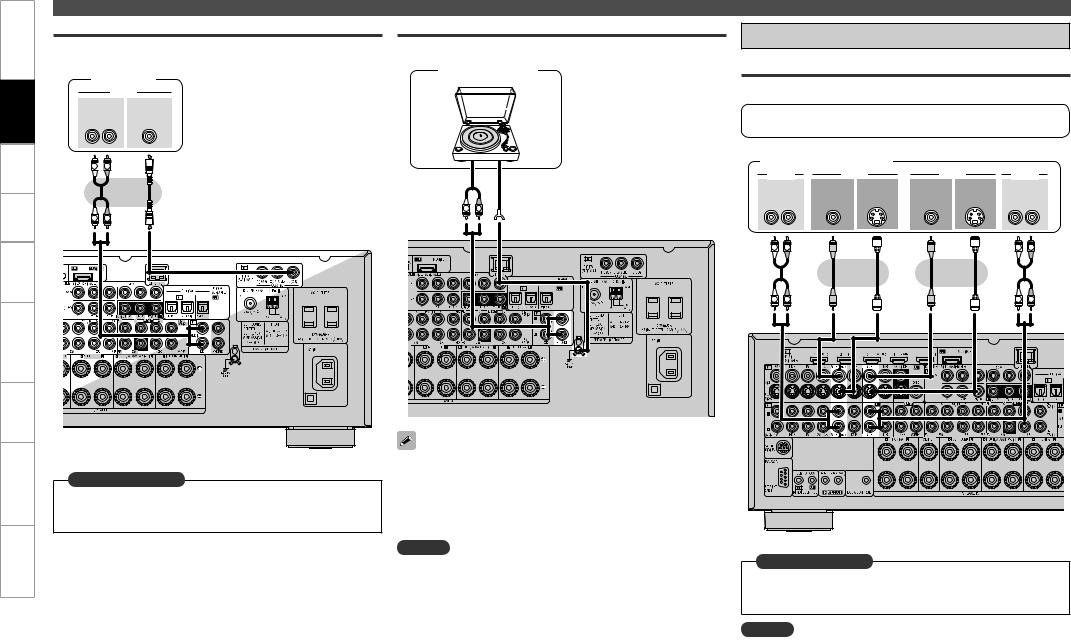
Specifications Troubleshooting Information Control Remote zone-Multi Playback Settings Connections Started Getting
Connecting Devices
CD Player
Select the terminal to use and connect the device.
CD player
"6%*0
"6%*0 $0"9*"-
065065
-3
L 
 R
R
L |
R |
Set as Necessary
Set this to change the input signal to which the input source is assigned.
“Input Assign” (vpage 45)
Record Player
Turntable (MM cartridge)
"6%*0 |
(/% |
|
065 |
||
|
||
L |
R |
•The AVR-3310CI is compatible with record players with an MM cartridge. When you connect to a record player with an MC cartridge, use a commercially available MC head amp or a step-up transformer.
•When you increase the volume without connecting the record player, there may be “booming” noise from the speakers.
NOTE
The SIGNAL GND terminal of the AVR-3310CI is not a safety ground connection. Connect it to reduce noise when noise is excessive. Note that depending on the record player, connecting the ground line may have the reverse effect of increasing noise. In this case, it is not necessary to connect the ground line.
Connecting the Recording Components
Video Cassette Recorder
Select the terminal to use and connect the device.
For instructions on HDMI connections, see “Connecting Devices Equipped with HDMI Terminals” on page 14.
Video cassette recorder
"6%*0 |
|
7*%&0 |
|
7*%&0 |
"6%*0 |
||
"6%*0 |
7*%&0 |
4 7*%&0 |
7*%&0 |
4 7*%&0 |
"6%*0 |
||
065 |
065 |
065 |
*/ |
*/ |
|
*/ |
|
- |
3 |
|
|
|
|
- |
3 |
L |
R |
|
|
|
|
L |
R |
L |
R |
L |
R |
Set as Necessary
Set this to change the input signal to which the input source is assigned.
“Input Assign” (vpage 45)
NOTE
To record video signals through the AVR-3310CI, use the same type of video cable for connection between the AVR-3310CI and the player as the cable used for connection between the AVR-3310CI and the recorder.
17
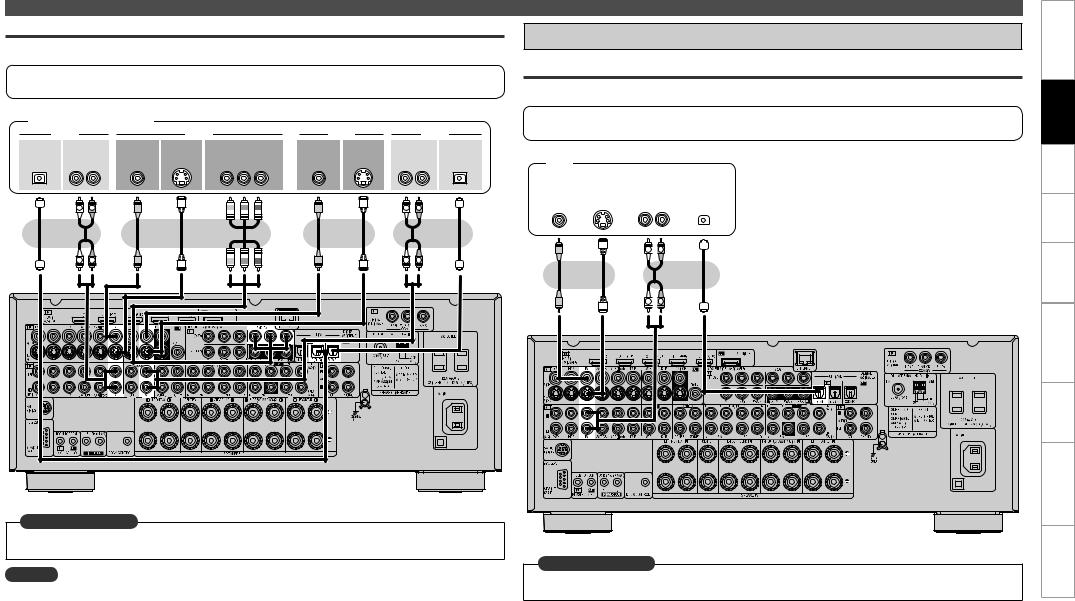
Digital Video Recorder
Select the terminal to use and connect the device.
For instructions on HDMI connections, see “Connecting Devices Equipped with HDMI Terminals” on page 14.
Digital video recorder |
|
|
|
|
|
|
|
|
|
|||
|
"6%*0 |
|
|
7*%&0 |
|
|
|
|
7*%&0 |
|
"6%*0 |
|
015*$"- |
"6%*0 |
7*%&0 |
4 7*%&0 |
$0.10/&/5 7*%&0 |
7*%&0 |
4 7*%&0 |
"6%*0 |
015*$"- |
||||
065 |
065 |
065 |
065 |
|
065 |
|
*/ |
*/ |
|
*/ |
*/ |
|
|
- |
3 |
|
|
: |
1# |
13 |
|
|
- |
3 |
|
|
L |
R |
|
|
|
|
|
|
|
L |
R |
|
|
L |
R |
|
|
|
|
|
|
|
L |
R |
|
Set as Necessary
Set this to change the input signal to which the input source is assigned.
“Input Assign” (vpage 45)
NOTE
•To record video signals through the AVR-3310CI, use the same type of video cable for connection between the AVR-3310CI and the player as the cable used for connection between the AVR-3310CI and the recorder.
•Do not connect the output of the component connected to the AVR-3310CI’s OPTICAL2 (DVR) output connector to any input connector other than OPTICAL2 (DVR).
Connecting Devices
Connect the Tuner
TV
Select the terminal to use and connect the device.
For instructions on HDMI connections, see “Connecting Devices Equipped with HDMI Terminals” on page 14.
TV
|
|
7*%&0 |
|
|
|
"6%*0 |
|
|
|
|
|
||||
|
|
|
|
|
|
|
|
|
|||||||
|
|
|
|
|
|
|
|
|
|
|
|
|
|
|
|
|
|
|
|
|
|
|
|
|
|
|
|
|
|
|
|
7*%&0 |
|
|
4 7*%&0 |
|
"6%*0 |
|
|
015*$"- |
|||||||
065 |
|
|
|
065 |
|
065 |
|
|
065 |
|
|||||
|
|
|
|
|
|
|
- 3 |
|
|
|
|
|
|
|
|
|
|
|
|
|
|
|
|
|
|
|
|
|
|
|
|
|
|
|
|
|
|
|
|
|
|
|
|
|
|
|
|
|
|
|
|
|
|
|
|
|
|
|
|
|
|
|
|
|
|
|
|
|
|
|
|
|
|
|
|
|
|
|
|
L 
 R
R
L 
 R
R
Set as Necessary
Set this to change the input signal to which the input source is assigned.
“Input Assign” (vpage 45)
Specifications Troubleshooting Information Control Remote zone-Multi Playback Settings Connections Started Getting
18

Specifications Troubleshooting Information Control Remote zone-Multi Playback Settings Connections Started Getting
Connecting Devices
Satellite Receiver / Cable Tuner (Set Top Box)
Select the terminal to use and connect the device.
For instructions on HDMI connections, see “Connecting Devices Equipped with HDMI Terminals” on page 14.
Satellite Receiver / Cable Tuner
|
|
7*%&0 |
|
|
|
"6%*0 |
|
|
|
"6%*0 |
|
||||
|
|
|
|
||||
|
|
|
|
|
|
||
7*%&0 |
4 7*%&0 |
|
$0"9*"- |
||||
065 |
|
065 |
|
065 |
065 |
||
-3
L 
 R
R
L |
R |
Set as Necessary
Set this to change the input signal to which the input source is assigned.
“Input Assign” (vpage 45)
SIRIUS Connector
•The AVR-3310CI is a SIRIUS Satellite Radio Ready® receiver. You can receive SIRIUS® Satellite Radio by connecting to the SiriusConnect Home Tuner and subscribing to the SIRIUS service.
•Plug the SIRIUS connector on the rear panel.
•Position the Home Tuner antenna near a south-facing window to receive the best signal.
For details, see “Listening to SIRIUS Satellite Radio” (vpage 55). When making connections, also refer to the operating instructions of the SiriusConnect Home Tuner.
SiriusConnect Home Tuner


 b When connecting digital audio
b When connecting digital audio
Set as Necessary
When connecting digital of the SiriusConnect Home Tuner, perform the setting “Digital”.
“Input Assign” (vpage 45)
19
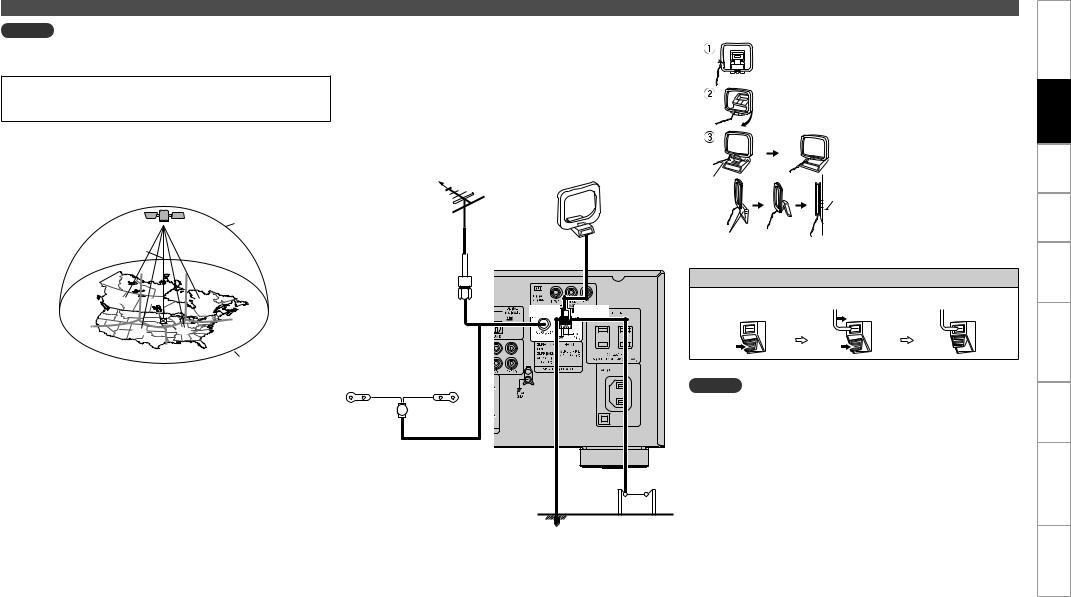
Connecting Devices
NOTE |
HD Radio Terminals |
n AM loop antenna assembly |
Keep the power cord unplugged until the SiriusConnect Home Tuner connection have been completed.
SIRIUS, XM and all related marks and logos are trademarks of Sirius XM Radio Inc. and its subsidiaries. All rights reserved. Service not available in Alaska and Hawaii.
n Positioning the Antenna
For a consistent satellite signal, the antenna must be positioned correctly. Use the following map to determine which area you are in and position the antenna accordingly.
|
|
|
|
SKY |
|
NORTH |
|
|
|
WEST |
q |
t |
r |
EAST |
|
|
|
||
|
w |
|
e |
|
HORIZON
SOUTH
Area 1 : Point the antenna toward the sky in the east, northeast, or southeast, either through a window or outside.
Area 2 : Point the antenna toward the sky in the north or northeast, either through a window or outside.
Area 3 : Point the antenna toward the sky in the north or northwest, either through a window or outside.
Area 4 : Point the antenna toward the sky in the west, northwest, or southwest, either through a window or outside.
Area 5 : Put the antenna outside and point it straight up. The antenna cannot be used indoors.
HD Radio is a service that is only available within the United States.
Direction of broadcasting station
FM antenna
AM loop antenna
(for HD Radio broadcasting, supplied)
•To prevent interference, install at least 3.3 feet/ 1 m away from the antenna connected to the AVR-3310CI’s other AM tuner terminal.
75 Ω/ohms Coaxial cable
FM indoor antenna (dipole, for HD Radio broadcasting, supplied)
Black |
White |
AM outdoor Ground antenna
Mount
Installation hole Mount on wall, etc.
Remove the vinyl tie and take out the connection line.
Bend in the reverse direction.
a.With the antenna on top of any stable surface.
b.With the antenna attached to a wall.
Connection of AM antennas
1. Push the lever. |
2. Insert the conductor. 3. Return the lever. |
||||||||
|
|
|
|
|
|
|
|
|
|
|
|
|
|
|
|
|
|
|
|
NOTE
•Do not connect two FM antennas simultaneously.
•Even if an external AM antenna is used, do not disconnect the AM loop antenna.
•Make sure the AM loop antenna lead terminals do not touch metal parts of the panel.
Specifications Troubleshooting Information Control Remote zone-Multi Playback Settings Connections Started Getting
20
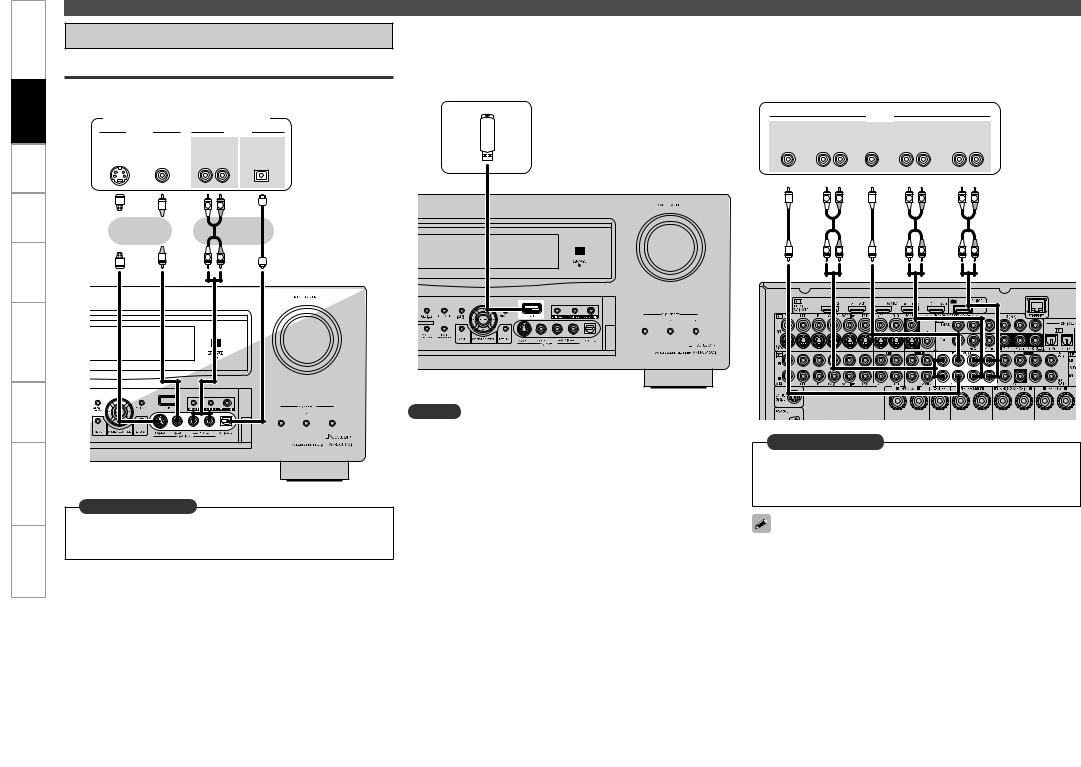
Specifications Troubleshooting Information Control Remote zone-Multi Playback Settings Connections Started Getting
Connecting Devices
Connections to Other Devices
Video Camera / Game Console
Select the terminal to use and connect the device.
USB Port |
|
Component with Multi-channel Output connectors |
||||
When you connect a USB memory device to the USB port, you can |
The video signal can be connected in the same way as a Blu-ray Disc |
|||||
enjoy music, etc., stored on the USB memory device. |
player / DVD player (vpage 16 “Blu-ray Disc Player / DVD Player”). |
|||||
|
|
|
|
|
|
|
|
USB memory |
|
|
Blu-ray Disc player / DVD player / |
||
|
device |
|
|
External decoder |
|
|
Video camera / Game console
7*%&0 |
"6%*0 |
4 7*%&0 |
|
7*%&0 |
|
||||
065 |
|
065 |
|
||||
|
|
|
|
|
|
|
|
|
|
|
|
|
|
|
|
|
|
|
|
|
|
|
|
|
|
|
|
|
|
|
|
|
|
|
|
|
|
|
|
|
|
|
|
|
|
|
|
|
|
|
|
|
|
|
|
|
|
|
|
|
|
|
|
|
|
|
|
|
|
|
|
|
|
|
|
|
|
|
|
|
|
|
|
|
|
|
|
|
|
|
|
|
|
|
|
|
|
|
|
|
|
|
|
"6%*0 |
015*$"- |
|
065 |
065 |
|
- |
3 |
|
L |
R |
|
L |
R |
|
NOTE
|
|
|
"6%*0 |
|
|
|
46# |
'30/5 |
$&/5&3 463306/% |
463306/% |
|||
800'&3 |
|
|
|
|
#"$, |
|
|
- |
3 |
- |
3 |
- |
3 |
|
L |
R |
L |
R |
L |
R |
L |
R |
L |
R |
L |
R |
Set as Necessary
Set this to change the input signal to which the input source is assigned.
“Input Assign” (vpage 45)
Do not use an extension cable when connecting a USB memory device. This may cause radio interference with other devices.
Set as Necessary
To play analog signals input from the external input (EXT. IN)
terminal, set “Input Mode” (vpage 49) to “EXT. IN”.
“EXT. IN” can also be selected with [INPUT MODE] on the main remote control unit.
When a device is connected to the SBL/SBR terminal of the external input terminals (EXT. IN), set “Amp Assign” (vpage 34) to “Normal”.
21
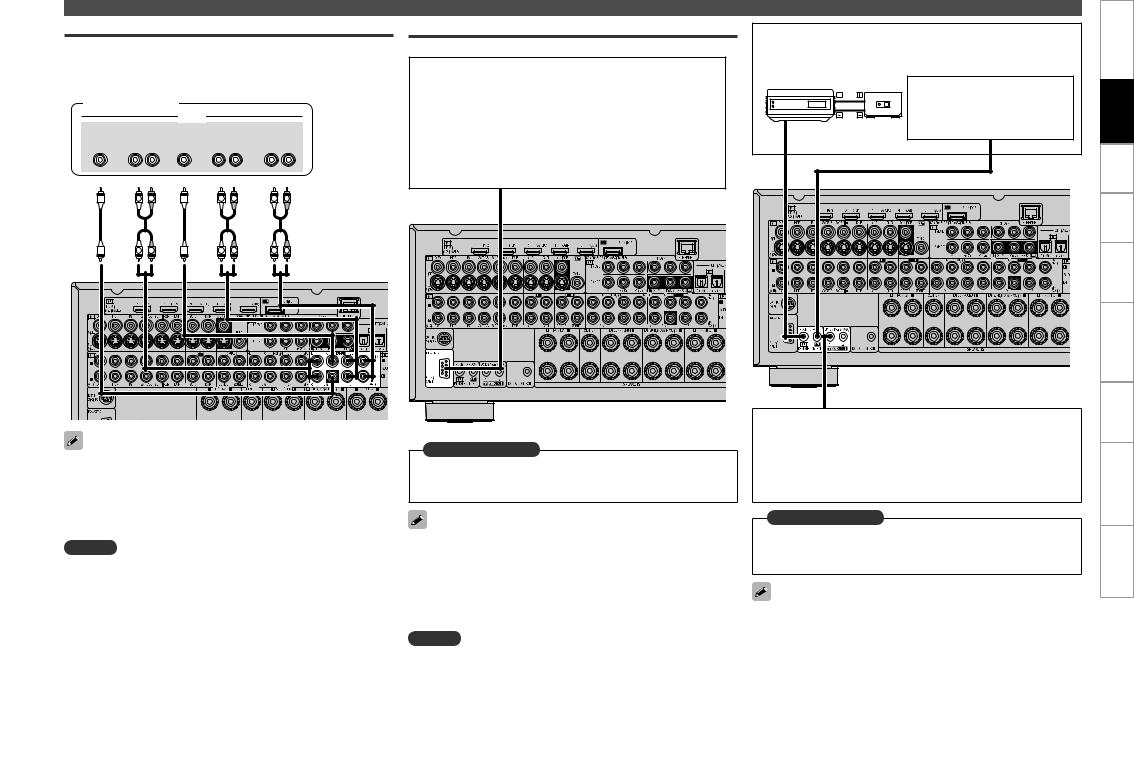
External Power Amplifier
•Select the terminal to use and connect the device.
•Connect when using an external power amp or an amp you already have.
Power amplifier
|
|
|
"6%*0 |
|
|
|
46# |
'30/5 |
$&/5&3 463306/% |
463306/% |
|||
800'&3 |
|
|
|
|
#"$, |
|
|
- |
3 |
- |
3 |
- |
3 |
|
L |
R |
L |
R |
L |
R |
External Controller
n RS-232C connector
When you connect an external control device, you can control the AVR-3310CI with the external control device. Perform the operation below beforehand.
q Turn on the AVR-3310CI’s power.
w Turn off the AVR-3310CI’s power from the external controller.
e Check that the AVR-3310CI is in the standby mode.
L |
R |
L |
R |
L |
R |
Connecting Devices
n REMOTE CONTROL jacks
Infrared |
|
Infrared |
retransmitter |
sensor |
|
"69 |
Input |
Output |
065 |
|
|
Extension jack for future use. (Connect devices corresponding with room to room function to this jack.)
•When using just one surround back speaker, connect it to the left channel (L).
•Use the volume control on the subwoofer to control subwoofer volume.
•If the subwoofer volume sounds low, use the volume control provided on the subwoofer to adjust the volume.
NOTE
•When speakers have been connected to PRE OUT terminals, do not connect the speakers to the speaker terminals.
•The channel output from the PRE OUT SBL and SBR terminals changes depending on the “Amp Assign” setting (vpage 34).
Set as Necessary
Set this to use the RS-232C connector for the DENON RF remote controller.
“232C Port” (vpage 43)
When using the AVR-3310CI in combination with the DENON RF remote controller (RC-7000CI, sold separately) or RF remote receiver (RC-7001RCI, sold separately), two-way communication is enabled. The AVR-3310CI’s status information as well as iPod and
Internet audio music files can be browsed watching the RF Remote
Controller’s display. For details, refer to the operating instructions of the respective devices.
NOTE
On the GUI menu, when setting “232C Port” to “2Way Remote”, you cannot use the RS-232C connector as an external controller (vpage 43).
n TRIGGER OUT jacks
The TRIGGER OUT output terminal outputs a maximum 12 V/150 mA electrical signal. When a device with TRIGGER IN terminal is connected via a monaural mini-plug, the connected device’s power on/standby can be controlled through linked operation to the AVR-3310CI.
Set as Necessary
Set to change the conditions for linked operation via the TRIGGER OUT 1 or TRIGGER OUT 2 terminal.
“Trigger Out1” or “Trigger Out2” (vpage 43)
When connecting a 2nd device, connect to the TRIGGER OUT 2 terminal in the same way as the TRIGGER OUT 1 terminal.
Specifications Troubleshooting Information Control Remote zone-Multi Playback Settings Connections Started Getting
22

Specifications Troubleshooting Information Control Remote zone-Multi Playback Settings Connections Started Getting
Connecting Devices
Connecting to a Home Network (LAN)
When you connect the AVR-3310CI to a home network, you can enjoy listening to music files stored on your PC, internet radio audio and other sources. You can also control the AVR-3310CI from your PC via the Web browser.
Internet
Computer
Modem
To WAN side |
|
To LAN port |
|
To LAN port |
LAN port/ |
|
Ethernet |
|
connector |
Router
For connections to the Internet, contact an ISP (Internet Service Provider) or a computer shop.
Required system
n Broadband Internet connection n Modem
n Router
When using the AVR-3310CI, we recommend you use a router equipped with the following functions:
•Built-in DHCP server
This function automatically assigns IP addresses on the LAN.
•Built-in 100BASE-TX switch
When connecting multiple devices, we recommend a switching hub with a speed of 100 Mbps or greater.
n Ethernet cable (CAT-5 or greater recommended)
Some flat type Ethernet cables are easily affected by noise. We recommend using a normal type cable.
n Computer
GRecommended systemH
•OS :
Windows® XP Service Pack2 or later, Windows Vista
•Software (Prepare one of the following.)
•Windows Media Player ver.11
•DLNA-compatible server software
•Internet browser :
Microsoft Internet Explorer 6 or later
•LAN port
•300 MB or more free disk space
b Operation is possible with DLNA servers other than the above, but such DLNA servers are not supported. For details, check the Web.
NOTE
•A contract with an ISP is required to connect to the Internet.
No additional contract is needed if you already have a broadband connection to the Internet.
•The types of routers that can be used depend on the ISP. Contact an ISP or a computer shop for details.
•Depending on the server, video files may be displayed, but they cannot be played on the AVR-3310CI.
•If you have an Internet provider contract for a line on which network settings are made manually, make the settings at “Network Connecting” (vpage 38).
•With the AVR-3310CI, it is possible to use the DHCP and Auto IP functions to make the network settings automatically.
•When using the AVR-3310CI with the broadband router’s DHCP function enabled, the AVR-3310CI automatically performs the IP address setting and other settings.
When using the AVR-3310CI connected to a network with no DHCP function, make the settings for the IP address, etc., at “Network Connecting” (vpage 38).
•The AVR-3310CI is not compatible with PPPoE. A PPPoE-compatible router is required if you have a contract for a line of the type with which the PPPoE is set.
•Depending on the ISP with which you have your contract, it may be necessary to make proxy server settings to use the Internet radio function. If you made proxy server settings on the computer to connect to the Internet, make the proxy server settings on the AVR3310CI in the same way.
23
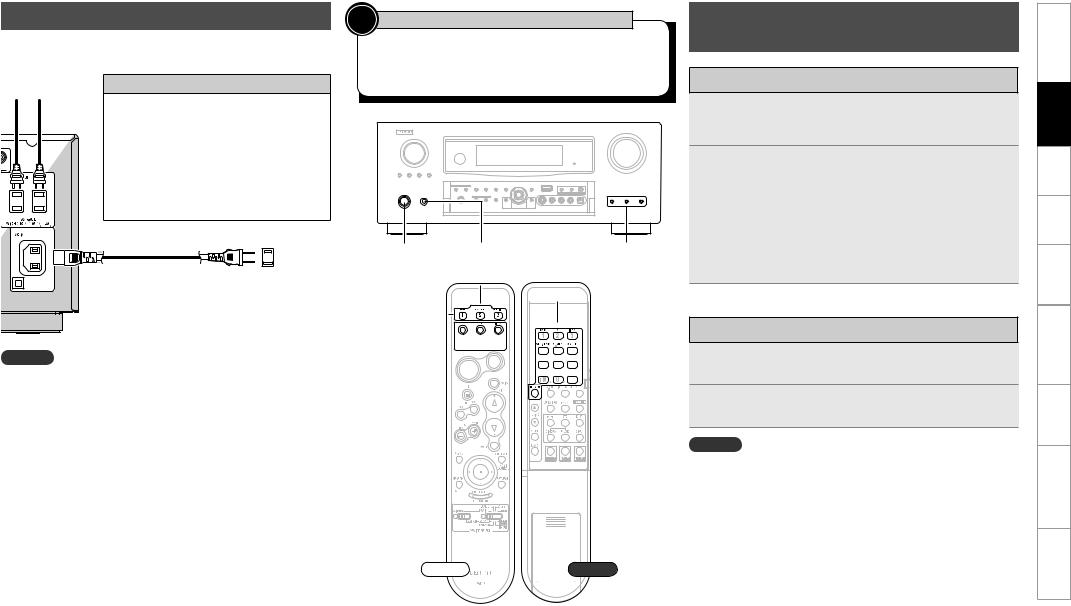
Connecting the Power Cord
Wait until all connections have been completed before connecting the power cord.
Connection to the AC outlet
 • These outlets supply power to external audio equipment.
• These outlets supply power to external audio equipment.
• Audio equipment with a total power consumption of 120 W (1 A) can be connected.
• The power supply turns on and off together
with <ON/STANDBY>. When set to “ON”,
power is supplied from the outlet. When set to “STANDBY”, no power is supplied.
 Symbols used to indicate buttons in this manual
Symbols used to indicate buttons in this manual
Button located on both the main unit
and the remote control unit  BUTTON Button only on the main unit
BUTTON Button only on the main unit  <BUTTON> Button only on the remote control unit
<BUTTON> Button only on the remote control unit  [BUTTON]
[BUTTON]
Power cord |
|
(included) |
To household power |
|
|
|
outlet |
|
(AC 120 V, 60 Hz) |
NOTE
•Insert the AC plugs securely. Incomplete connections could cause noise.
•Only use the AC outlets to plug in audio equipment. Do not use them as power supplies for hairdryers or anything other than audio equipment.
<ON/STANDBY> <POWER>
[ON/SOURCE]  [OFF]
[OFF] 











QUICK SELECT 
[INPUT 








 SOURCE
SOURCE 
 SELECT]
SELECT] 



QUICK SELECT

 [MAIN OFF]
[MAIN OFF]









 [MAIN ON]
[MAIN ON]
[INPUT






 SOURCE
SOURCE 






 SELECT]
SELECT]
Front |
Rear |
Once Connections are
Completed
Turning the Power On
1Press <POWER>.
The power indicator lights red and the power is set to the standby mode.
2Press [ON/SOURCE] or <ON/STANDBY>.
The power indicator flashes green and the power turns on.
b Also press [INPUT SOURCE SELECT] or QUICK SELECT when in
standby mode, the power turns on.
When [INPUT SOURCE SELECT] has been pressed, the input source set with the [INPUT SOURCE SELECT] is set. If a QUICK SELECT has been pressed, the input source stored in the memory
for the quick select function is set (vpage 80 “Saving Frequently Used Settings (Quick Select Function)”).
Turning the Power Off
1Press [OFF] or <ON/STANDBY>.
The power is set to the standby mode.
2Press <POWER>.
The power indicator turns off, and so does the power.
NOTE
•Power continues to be supplied to some of the circuitry even when
the power is in the standby mode. When leaving home for long periods of time or when traveling, either press <POWER> to turn off the power, or unplug the power cord from the power outlet.
•When using ZONE2 or ZONE3, it is possible to turn the power for the MAIN ZONE only on or off by pressing [MAIN ON] or [MAIN OFF].
Specifications Troubleshooting Information Control Remote zone-Multi Playback Settings Connections Started Getting
24
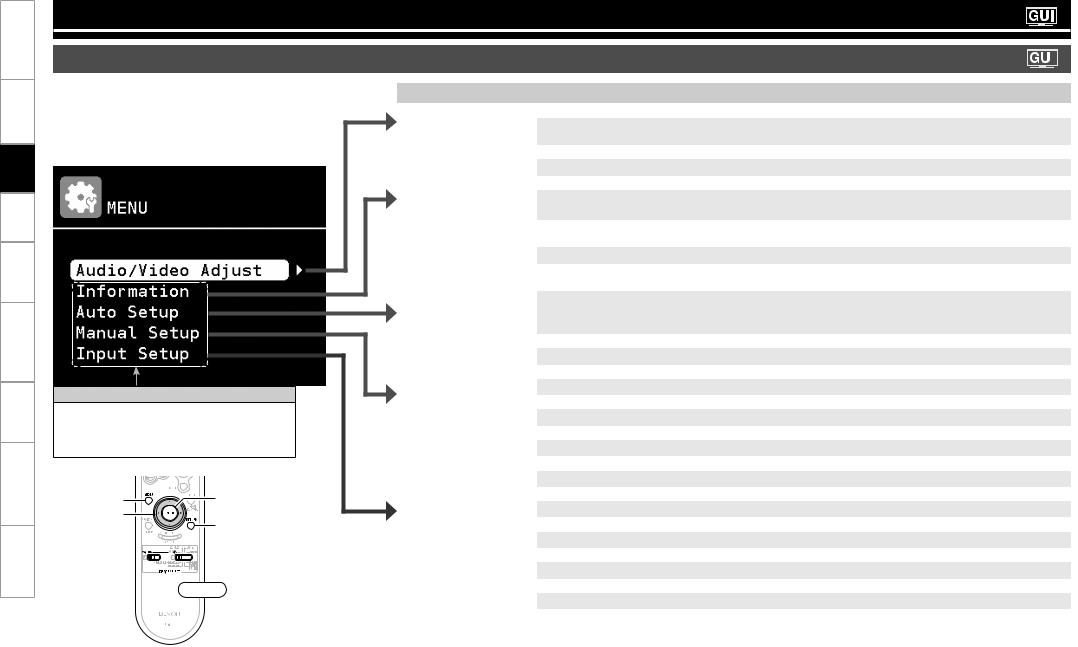
Specifications Troubleshooting Information Control Remote zone-Multi Playback Setting Connections Started Getting
Settings
GUI Menu Map
Pressing MENU displays the GUI menu. From this menu, you can move to various setting screens.
Items that only need to be set once
Set these for example upon purchase.
Once these items are set, there is no need to set them again unless the speaker layout or the connected speakers have been changed.
MENU |
ENTER |
uiop |
RETURN |
|
|
|
Front |
|
|
|
|
|
|
|
|
|
|
|
|
|
|
|
|
Setting items |
|
Detailed items |
Description |
Page |
|||
|
|
|
|
|
|
|
|
Audio / Video Adjust |
|
Audio Adjust |
Adjust various audio parameters. |
71 |
|
|
|
Adjust |
various audio and |
Picture Adjust |
Adjust various video parameters. |
75 |
|
|
|
video parameters. |
|
|
|
|
|
|
|
Information |
|
Status |
Shows information about current settings. |
76 |
|
|
|
Show |
information |
about |
Audio Input Signal |
Shows information about audio input signals. |
76 |
|
|
receiver |
settings, |
input |
HDMI Information |
Shows information about HDMI input/output signals and monitor. |
76 |
|
|
signals, etc. |
|
|
|
|
|
|
|
|
Auto Surround Mode |
Shows information about settings stored for the auto surround |
76 |
|
|
||
|
|
|
|
|
|||
|
|
|
|
mode. |
|
|
|
|
|
|
Quick Select |
Shows information about settings stored for the Quick Select |
76 |
|
|
|
|
|
|
function. |
|
|
|
|
|
|
Preset Channel |
Shows information about preset channels. |
76 |
|
|
Auto Setup |
|
Audyssey™ Auto Setup |
Makes the optimum settings for the speakers being used |
28 |
|
|
|
Makes the optimum speaker |
|
automatically. |
|
|
|
||
settings and corrects for the |
Parameter Check |
Check Audyssey Auto Setup measurement results. |
33 |
|
|
||
acoustic characteristics of |
|
This item is only displayed after Audyssey Auto Setup procedure has |
|
|
|
||
the room. |
|
|
been performed. |
|
|
|
|
Manual Setup |
|
Speaker Setup |
Sets the speaker size and distance, the channel level, etc. |
34 |
|
|
|
Use this to make various |
HDMI Setup |
Make settings for HDMI video/audio output. |
36 |
|
|
||
types of detailed settings. |
Audio Setup |
Make settings for audio playback. |
37 |
|
|
||
|
|
|
|
|
|||
|
|
|
Network Setup |
Make network settings. |
38 |
|
|
|
|
|
Zone Setup |
Make settings for audio playback in the multi-zone system. |
41 |
|
|
|
|
|
Option Setup |
Make various other settings. |
41 |
|
|
Input Setup |
|
Auto Preset |
Use the auto preset function to program radio stations. |
50 |
|
|
|
Use this to make settings |
Preset Skip |
Set the preset memories that you do not want to display when tuning. |
50 |
|
|
||
related |
to playing |
input |
|
|
|
|
|
Preset Name |
Assign name to a preset memory. |
51 |
|
|
|||
sources. |
|
|
|
|
|
|
|
|
Parental Lock |
Set the Parental Lock. |
51 |
|
|
||
|
|
|
|
|
|||
|
|
|
Antenna Aiming |
Adjust the SIRIUS reception sensitivity. |
51 |
|
|
|
|
|
Input Assign |
Change input connector assignment. |
45 |
|
|
|
|
|
Video |
Makes the video settings. |
48 |
|
|
|
|
|
Input Mode |
Sets the audio input mode and decode mode. |
49 |
|
|
|
|
|
Rename |
Change the display name for this source. |
49 |
|
|
|
|
|
Source Level |
Adjust the playback level of the audio input. |
49 |
|
|
|
|
|
Playback Mode (for iPod) |
Make settings for “iPod” playback. |
50 |
|
|
|
|
|
Playback Mode (for NET/USB) |
Make settings for “NET/USB” playback. |
50 |
|
|
|
|
|
Still Picture |
Make settings for still picture playback. |
50 |
|
|
25

GUI Menu Operation
When a TV is connected to the AVR-3310CI, the GUI menu, sound field parameters, etc., can be displayed on the TV.
This allows you to operate the AVR-3310CI and make settings on it while looking at the GUI menu displayed on the TV.
1Press MENU.
The GUI menu is displayed on the TV screen.
2Pressoperated.uiop to select the menu to be set or b To return to the previous item, press o or RETURN.
3Press RETURN to enter the setting.
b Select “Default”, then press ENTER to reset to the default setting.
n Exiting the GUI Menu
Press MENU while the GUI menu is displayed. The GUI menu display disappears.
Example of the Display of the GUI Mark at a Title
Items for which this mark is indicated at the title can be operated from the GUI.
We recommend performing such operations from the GUI.
Making Detailed Settings
(Manual Setup)
Examples of GUI Menu Screen Displays
Typical examples are described below.
GExample 1H Menu selection screen (Top menu)
 z1
z1
 z2
z2
 z3
z3
z1 : Currently selected setup item
z2 : List of currently selected setup items z3 : Guide text for the currently selected
setup item
Press i to select “HDMI Setup”
and then press p.
(Or press ENTER.)
GExample 2H Audyssey Auto Setup screen
(with illustration)
 z6
z6
z7 |
z8 |
|
z11 |
z9 |
|
|
|
z10 |
|
|
z6 |
: History item |
|
z7 |
: Operation guidance text |
|
z8 |
: Operation step |
|
z9 |
: Illustration |
|
z10 |
: Guide text for the currently selected |
|
|
setup item |
|
z11 |
: Operation button guidance |
|
|
n List |
||||
|
|
|
|
|
|
|
|
|
Switch to the next item |
|
|
|
|
|
|||
|
|
|
|
|
|
|
|
|
(Use p or ENTER to switch.) |
||
|
|
|
|
|
|
z4 |
|
|
Selected item |
||
z5 |
|
|
|
b Switch the selected |
|||
|
|||
|
item using ui. |
||
z4 : History item
z5 : Currently selected setup item
Specifications Troubleshooting Information Control Remote zone-Multi Playback Setting Connections Started Getting
26
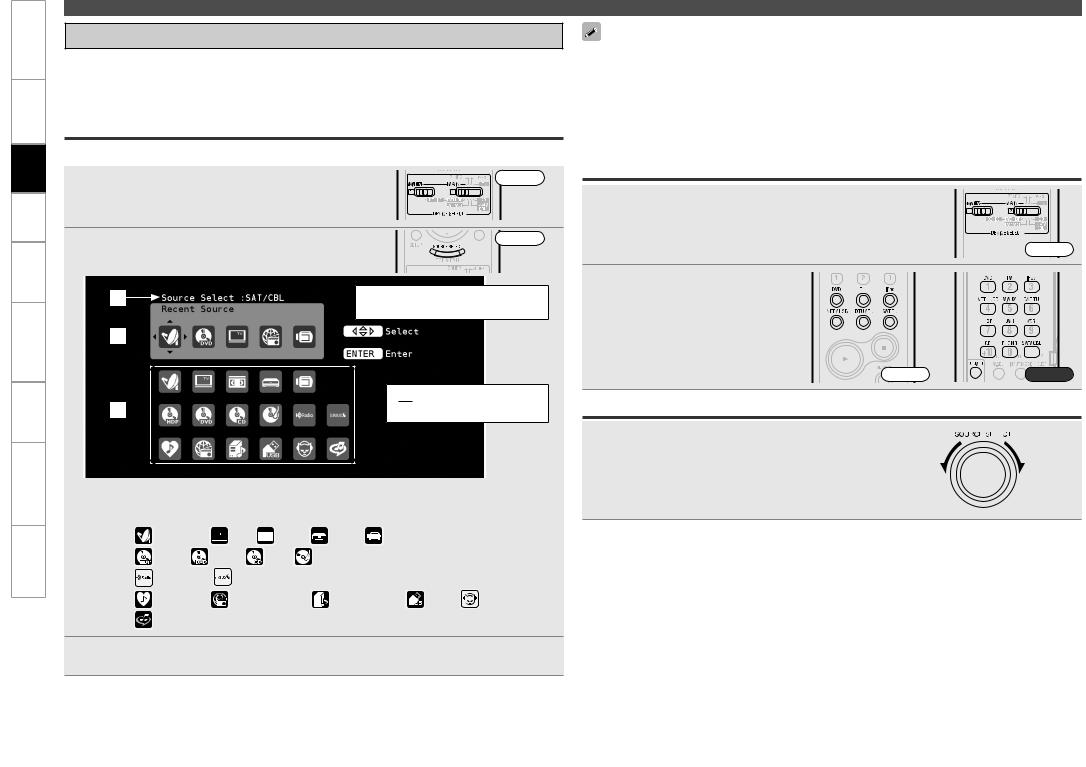
Specifications Troubleshooting Information Control Remote zone-Multi Playback Setting Connections Started Getting
GUI Menu Operation
Selecting the Input Source
There are three ways to select the input source, as described below.
q Selecting the input source using the Source Select menu (GUI menu)
w Selecting the input source using the [INPUT SOURCE SELECT] (Main remote control unit) e Selecting the input source using the <SOURCE SELECT> (Main unit)
q Using the Input Setup Menu
The input source can also be selected using the source selection menu.
1 |
Set [DEVICE SELECT 1] to “MAIN/TV” and |
Front |
[DEVICE SELECT 2] to “MAIN”. |
|
2 Press [SOURCE SELECT].
Display the “Source Select” menu.
q
w
e
Front
The currently selected input source is highlighted.
“ ” is displayed when using a control dock for iPod.
” is displayed when using a control dock for iPod.
q Input Source : The name of the highlighted input source is displayed.
w Recently used sources : The recently used input sources (up to 5) are displayed. e Icons for the input sources in the different categories are displayed.
Video |
: |
(SAT/CBL), |
|
(TV), |
(VCR), |
(DVR), |
(V.AUX) |
|
|
|
|
|
|
||||||||
|
|
|
||||||||
Player |
: |
(HDP), |
(DVD), |
(CD), |
(PHONO) |
|
|
|
|
|
Tuner |
: |
(HD Radio), |
|
(SIRIUS) |
|
|
|
|
|
|
Network: |
(Favorites), |
|
(Internet Radio), |
(Media Server), |
|
(USB), |
(Napster), |
|||
|
|
|||||||||
|
|
(Rhapsody) |
|
|
|
|
|
|
|
|
3 Use uio p to select the input source icon, then press ENTER.
The input source is set and the source selection menu is turned off.
•Use the device selection buttons on the main remote control unit to set the device to be operated beforehand.
•When using with an iPod connected directly to the AVR-3310CI’s USB pot, select “USB” for the input source.
•Input sources that are not going to be used can be set ahead of time. Make this setting at “Source Delete” (vpage 42).
•To turn off the source selection menu without selecting an input source, press [SOURCE SELECT] again.
w Operating on the Main Remote Control Unit
1 Set [DEVICE SELECT 1] to “MAIN/TV” and [DEVICE SELECT 2] to “MAIN”.
Front
2 Press [INPUT SOURCE SELECT].
The desired input source can be
selected directly.
Front |
Rear |
e Operating on the Main Unit
Turn <SOURCE SELECT>.
bIf “ZONE2/3/ Rec Select”, “Video Select” or “Tuning Preset” mode is selected for the input source, press <SOURCE> before turning the <SOURCE SELECT>.
27
